Using Benchmarking Data to Enhance Recruitment: Lessons from Industry Leaders


Elizabeth Parker
- September 27, 2023
- Reporting and Analytics
Recruitment lies at the heart of organizational success. The ability to attract, identify, and retain top talent directly impacts an organization’s growth, innovation, and competitive edge. In today’s dynamic and ever-evolving job market, staying ahead in the recruitment game is imperative. This is where benchmarking, a powerful strategic tool , comes into play.
Benchmarking is not a new concept, but its application to recruitment strategies has gained significant traction in recent years. By analyzing and adopting the best practices of industry leaders, organizations can fine-tune their recruitment processes , reduce time-to-hire , enhance candidate experiences, and ultimately secure the best-fit talent.
This article delves into the world of recruitment benchmarking, offering insights into how industry leaders have leveraged this approach to revolutionize their talent acquisition efforts. By exploring real-world case studies and highlighting common themes among top performers, we’ll uncover valuable lessons that can be applied to any organization’s recruitment strategies.
Hirebee ensures that you are able to find the best candidates in the market for your team through industry-leading candidate screening as well as candidate sourcing features.
Join us on this journey as we discover how benchmarking data can serve as a compass guiding organizations toward a brighter, more talent-rich future.
Table of Contents
Understanding Benchmarking in Recruitment
Benchmarking is a critical process that helps organizations assess their performance and identify areas for improvement by comparing their practices and results to those of industry leaders or competitors. In the context of recruitment, benchmarking enables companies to evaluate the effectiveness of their hiring processes, strategies, and outcomes. To fully grasp the value of benchmarking in recruitment, it’s essential to delve into its core concepts:
What is benchmarking?
Benchmarking is a systematic approach that involves measuring an organization’s performance against external standards or best-in-class practices. In recruitment, it entails evaluating various aspects, such as time-to-fill positions, cost-per-hire, candidate quality, and retention rates, to understand how well an organization’s recruitment efforts stack up against top-performing peers.
Types of benchmarking
- Competitive benchmarking: This involves comparing recruitment practices directly to competitors within the same industry.
- Functional benchmarking: Organizations may compare their recruitment processes with companies in different industries that excel in specific functions.
- Process benchmarking: Focusing on specific recruitment processes (e.g., sourcing, interviewing) and comparing them to industry leaders or best practices.
How benchmarking applies to recruitment
Benchmarking in recruitment empowers organizations to gain insights from industry leaders, identify areas needing improvement, and implement data-driven strategies to enhance their talent acquisition efforts. By understanding these foundational concepts, companies can embark on a journey to leverage benchmarking data effectively for recruitment success.
Identifying Industry Leaders
In the realm of recruitment, identifying industry leaders is a crucial initial step in harnessing benchmarking data to enhance your strategies. Industry leaders are organizations that have consistently excelled in attracting top talent and have established themselves as trendsetters in recruitment practices.

To identify these leaders, comprehensive research and data collection are essential. This involves delving into the recruitment landscape of your industry, studying market reports, and closely examining the strategies and practices of notable companies. Furthermore, it’s essential to consider their reputation, employee satisfaction, and turnover rates .
For instance, a technology company known for its cutting-edge recruitment technology or an e-commerce giant renowned for its seamless candidate experience could be considered industry leaders. Additionally, industry awards and recognitions can serve as indicators of leadership in recruitment.
By identifying and studying these leaders, you gain valuable insights into what works best in your specific industry, serving as a foundation for your benchmarking efforts and eventual enhancements to your recruitment strategies.
Gathering Benchmarking Data
Effective benchmarking in recruitment begins with the collection of relevant data to compare and analyze. This step is crucial in understanding how your recruitment strategies stack up against industry leaders and identifying areas for improvement.
Recruitment metrics and key performance indicators (KPIs):
To initiate benchmarking, it’s essential to define the specific metrics and KPIs that are most relevant to your organization’s recruitment goals. Common recruitment metrics include time-to-fill, cost-per-hire, quality of hire, and candidate satisfaction. These metrics serve as the foundation for evaluating the effectiveness of your recruitment efforts.
Data sources:
- Internal data: Your organization’s historical recruitment data is a valuable resource. It includes past hiring statistics, applicant tracking system (ATS) data, and performance analytics. Collecting this data allows you to establish a baseline for your current recruitment performance.
- External data: To benchmark effectively, you need external data to compare your performance to industry standards. This data can be acquired through industry reports, surveys, or partnerships with benchmarking organizations. External data provides critical context for assessing your recruitment strategies in a broader industry perspective.
Analyzing and interpreting benchmarking data:
Once you’ve gathered both internal and external data, the next step is to analyze and interpret it. Compare your organization’s performance against industry leaders and identify areas where you excel and where there’s room for improvement. This analysis will inform the adjustments and enhancements needed in your recruitment strategies to align them with best practices and industry benchmarks. Effective data analysis is the key to making informed decisions and driving positive changes in your recruitment processes.
Lessons from Industry Leaders
In this section, we delve into valuable lessons learned from industry leaders in recruitment strategies. Through careful analysis of benchmarking data , we uncover insights and case studies that shed light on what makes certain organizations stand out in their talent acquisition efforts.

Case studies of successful recruitment strategies:
- We examine how Company A utilizes innovative sourcing techniques, such as AI-driven candidate matching, to identify top talent efficiently.
- Company B’s focus on creating a stellar candidate experience sets a benchmark for others to follow, showcasing how positive interactions can lead to better hires.
- Company C leverages extensive data analytics to make informed recruitment decisions, demonstrating the power of data-driven strategies.
Common themes among industry leaders:
We identify recurring themes and strategies that successful organizations in recruitment share, including a commitment to diversity, streamlined processes, and continuous improvement.
Key takeaways for recruitment strategies:
This section distills the key lessons learned from industry leaders, offering actionable insights that organizations can implement to enhance their own recruitment strategies and remain competitive in the talent acquisition landscape.
Implementing Benchmarking Data
Once you’ve gathered valuable benchmarking data from industry leaders, the next crucial step is to translate these insights into actionable recruitment strategies within your own organization.
Adapting Strategies to Match Industry Leaders : Start by identifying the specific practices and approaches that have led industry leaders to success. Whether it’s innovative sourcing methods, a focus on candidate experience, or data-driven decision-making, understand how these strategies align with your organization’s goals and culture. Tailor these insights to fit your unique needs and resources.
Setting Goals and Objectives : Clearly define the goals and objectives you aim to achieve with your enhanced recruitment strategies. Establish measurable targets based on the benchmarking data, such as improving time-to-fill , reducing turnover, or enhancing diversity in your workforce.
Monitoring Progress and Adjusting Strategies : Implement a robust tracking and measurement system to monitor the effectiveness of your new strategies. Regularly assess your progress against the established benchmarks and adjust your tactics as needed to stay aligned with industry leaders and achieve your recruitment goals.
By implementing these steps, your organization can harness the power of benchmarking data to elevate your recruitment strategies and remain competitive in the ever-evolving job market.
Overcoming Challenges
Incorporating benchmarking data into your recruitment strategies can be immensely beneficial, but it’s not without its challenges. Recognizing and addressing these obstacles is essential for success:
- Data Quality and Consistency : Ensuring that benchmarking data is accurate and consistent across sources and time periods can be challenging. Regularly auditing and validating data sources can help mitigate this issue.
- Data Privacy and Security : Handling sensitive candidate and employee data requires strict adherence to privacy regulations. Implement robust data protection measures to safeguard information and comply with legal requirements.
- Interpreting Data : Interpreting benchmarking data accurately can be complex. It’s crucial to have data analytics expertise within your team or to collaborate with professionals who can help decipher the insights.
- Resource Constraints : Small organizations may lack the resources or budget for comprehensive benchmarking efforts. Consider leveraging cost-effective tools and focusing on critical metrics.
- Resistance to Change : Employees and stakeholders may resist changes based on benchmarking insights. Effective communication and demonstrating the benefits of these changes are key to overcoming resistance.
- Comparability : Industries and companies vary widely, making direct comparisons challenging. Tailor benchmarking to your specific context, industry, and goals.
- Overreliance on Data : While data is invaluable, it should complement, not replace, human judgment and intuition in recruitment decisions.
Addressing these challenges strategically will enable you to harness benchmarking data effectively in enhancing your recruitment strategies.
Best Practices
Incorporating benchmarking data into your recruitment strategies can be a transformative process, but to make the most of it, it’s essential to follow best practices.

Here are some key guidelines to ensure your benchmarking efforts yield meaningful results and drive positive changes in your recruitment processes:
- Define Clear Objectives: Begin by setting specific and measurable objectives for your benchmarking initiative. What aspects of recruitment do you aim to improve? Whether it’s time-to-fill, cost-per-hire , or candidate satisfaction, having well-defined goals will keep your efforts focused.
- Select Relevant Metrics: Choose the right metrics and KPIs that align with your objectives. Industry leaders may track different metrics, so tailor your selection to match your organization’s unique needs and goals.
- Data Quality Matters: Ensure the accuracy and reliability of your data sources. Inaccurate or outdated information can lead to misguided decisions. Invest in data validation and cleansing processes.
- Benchmark with Purpose: Don’t just collect data for the sake of it. Analyze the benchmarking data to gain actionable insights. Identify trends, gaps, and areas where your recruitment processes can improve.
- Learn from Industry Leaders: Study industry leaders’ strategies closely but adapt them to your organization’s culture and goals. What works for them may need modifications to fit your context.
- Regularly Review and Adjust: Recruitment is an ever-evolving field. Continuously monitor your progress, make adjustments as needed, and stay updated with the latest trends and best practices.
- Engage Stakeholders: Involve key stakeholders in the benchmarking process. Their input and perspectives can provide valuable insights and ensure alignment with broader organizational objectives.
- Share Findings and Celebrate Success: Communicate the results and improvements achieved through benchmarking with your team and organization. Recognize and celebrate successes to maintain motivation and support for ongoing efforts.
- Stay Ethical and Compliant: Respect privacy and legal regulations throughout your benchmarking efforts. Ensure that data collection and sharing comply with relevant laws and ethical standards.
By adhering to these best practices, your organization can harness the power of benchmarking data to enhance recruitment strategies, stay competitive in the job market, and attract top talent. Remember that benchmarking is an iterative process, and continuous improvement is key to achieving long-term success in recruitment.
In conclusion, harnessing benchmarking data to refine recruitment strategies offers a compelling pathway to success in the dynamic landscape of talent acquisition. By studying industry leaders, gathering relevant data, and implementing best practices, organizations can achieve improved candidate sourcing, selection, and retention. These insights empower HR professionals to make informed decisions, enhance candidate experiences, and remain competitive. While challenges may arise, the benefits of benchmarking are undeniable. As the recruitment landscape continues to evolve, organizations that embrace this data-driven approach are better positioned to attract top talent and achieve long-term success in a rapidly changing job market.
Hirebee makes sure that you are able to make the most of your recruiting efforts, as you will no longer have to worry job distribution or reporting and analytics.
What is benchmarking in the context of recruitment strategies?
Benchmarking in recruitment involves comparing your organization’s recruitment processes and outcomes with those of industry leaders to identify areas for improvement and implement best practices.
Why is benchmarking important for recruitment strategies?
Benchmarking helps organizations understand how they stack up against industry leaders, allowing them to identify strengths and weaknesses in their recruitment efforts and make data-driven improvements.
How can I identify industry leaders for benchmarking purposes?
You can identify industry leaders through research, industry awards, and by examining companies known for their innovative and successful recruitment practices.
What types of data should I collect for benchmarking in recruitment?
Key performance indicators (KPIs) such as time-to-fill, cost-per-hire, retention rates, and candidate satisfaction are essential data points for benchmarking in recruitment.
Where can I find benchmarking data for recruitment?
Benchmarking data can be sourced from industry reports, professional associations, HR software solutions, and external consulting firms. Internal data can also be valuable for benchmarking purposes.
Don’t forget to share:
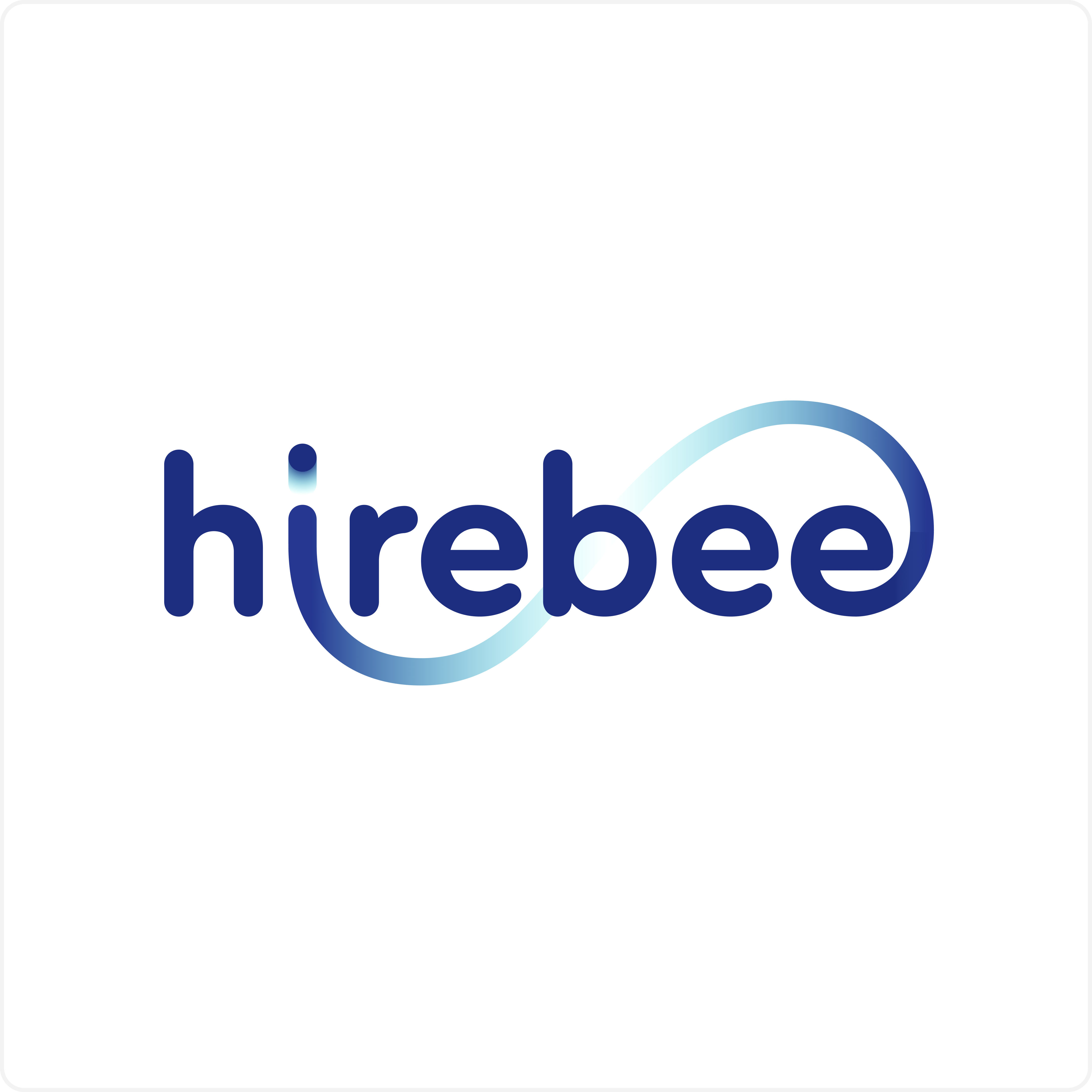
- Job Distribution
- Candidate Sourcing
- Candidate Relationship
- Candidate Screening
- Recruitment Automation
- Recruitment Marketing
- Candidate Survey
- Our contacts
- Terms of use
- Privacy policy
- Job Description
- Interview Questions
- Recruiting Email Template
- HR Email Templates
- HR Tips and Tutorials
- Customer Stories
- Our Contacts
- Terms of Use
- Privacy Policy
- Help Center
- 75 5th St NW, Atlanta, GA 30308, USA
- Email: [email protected]
- Phone: +1 (470) 809-9036
Copyright 2020-2024
All rights reserved.

- Apr 5, 2021
60 Recruitment Benchmarks Every HR Professional Needs to Know
Updated: Mar 27, 2023
Leading companies are leveraging external benchmarks and other HR data sources to find insights that can help them attract the right talent with the right skills at the right price. This form of recruiting analytics is particularly important during an ever-changing labor market like the one we’re experiencing today.
To build an optimized recruitment strategy, you’ll need to be armed with the most recent and relevant benchmarks.
For that, you’ll need these 60 recruitment benchmarks to help you better adjust and optimize your workforce strategies.
Table of Contents
Hiring costs benchmarks, hiring process benchmarks, hiring sources benchmarks, diversity hiring benchmarks, post offer benchmarks, 2021 hiring trends.

Hiring costs refer to the expenses associated with finding, screening, interviewing, hiring, and onboarding new hires. Being able to effectively manage hiring costs is a sign of a well-run recruitment team. The benchmarks below will help you understand how you’re doing relatively.
1. On average, the cost per hire for each recruit is $4,425 . (Source: SHRM )
2. On average, the cost per hire for an executive position is $14,936 . (Source: SHRM )
3. The average recruitment expenses to HR expenses ratio is 15% . (Source: SHRM )
4. The average recruiting agency fee is $20,283 per hire. (Source: Top Echelon )
5. On average, recruiting agency fee makes up 21.5% of the total recruitment budget. (Source: Top Echelon )
6. A relocation package costs companies between $21,327 and $24,913 for renters and between $61,622 and $79,429 for homeowners. (Source: Worldwide ERC )
7. Signing bonuses for managers and executives typically ranged from $10,000 to more than $50,000 . (Source: The Program on Negotiation (PON) at Harvard University )
8. The average cost of a bad hire is up to 30% of the employee’s first year compensation. (Source: U.S. Department of Labor )
9. Companies lost an average of $14,900 on every bad hire. (Source: CareerBuilder )
10. The average cost of losing a good hire is $29,600 . (Source: CareerBuilder )
11. The average cost per hire for a small business is $1,872 . (Source: Monster )
The average cost per hire for a recruit is $4,425 and $14,936 for an executive position. (Source: SHRM )

Companies with a lean hiring process can find better talent faster and cheaper. In order to achieve this, HR teams need to perform well from the very beginning of the hiring process all the way to the job offer and onboarding stages. The benchmarks below will help you to evaluate the efficiency of your hiring process.
12. 62% of small business owners have reported making a wrong hire. (Source: Monster )
13. 74% of surveyed companies said they have hired the wrong person for a position. (Source: CareerBuilder )
14. In 2019, 49% of job searches were conducted on mobile, compared to 51% of job searches on desktops. (Source: Monster )
15. 42% of resumes companies receive are from candidates who do not meet skills requirements. (Source: Robert Half )
16. 40% of hiring managers say that the skills gap will be their top hurdle in 2021. (Source: Monster )
17. 8% of employers say they have difficulty filling openings due to skills gaps. (Source: Monster )
18. Job ads that have social media in their distribution receive 114% more views . (Source: Monster )
19. Companies receive 71% more applicants to jobs posted with social media strategy, compared to those without one. (Source: Monster )
20. 29 is the average number of applicants companies receive per open requisition. (Source: Jobvite )
21. 38 days is the average time to fill an open position. (Source: Jobvite )
22. The average percentage of applicants that move to the interview stage is 12% . (Source: Jobvite )
23. The average percentage of interviews that move to the offer stage is 28% . (Source: Jobvite )
24. The average percentage of offers that turn into new hires is 95% . (Source: Jobvite )
25. The average number of qualified candidates per hire is 23.1 . (Source: Workable )
26. 50% of the jobs posted on job boards received the candidate that they’re looking for in the first week. (Source: Workable )
In 2017, the average time to fill an open position is 38 days (Source: Jobvite )

Today there are multiple avenues that recruiting teams can use to source candidates. Each hiring source has its advantages and disadvantages, but which ones are best for your hiring needs? Use the recruitment benchmarks below to determine how your team is doing and where your best hiring sources are.
27. 30% of all hires overall in 2016 are from employee referrals. (Source: SHRM )
28. Employee referral hires stay 70% longer than non-referral hires. (Source: ICISMS )
29. On average, 74% of open positions are filled externally. (Source: SHRM )
30. On average, 24% of open positions are filled internally. (Source: SHRM )
31. The average internal hiring rate has increased by 10% since 2015. (Source: LinkedIn )
32. Since the onset of COVID-19, the internal hiring rate has increased by nearly 20% compared to the same time last year. (Source: LinkedIn )
33. Employees stay 41% longer at companies with high internal hiring compared to those with low internal hiring. (Source: LinkedIn )
34. The average percentage of new hires to the total employee population is 30.2%. (Source: ADP )
35. The average percentage of managers promoted internally is 17.2%. (Source: ADP )
36. The average percentage of managers hired externally is 15.6% . (Source: ADP )
74% of open positions and 24% are filled internally. (Source: SHRM )

Diversity hiring is one of the most highly discussed and debated topics in the HR and recruiting world. Companies are trying to figure out what their goals for diversity hiring should be and which path they should take to meet them. Below is a wide range of hiring benchmarks that will help your team better measure, track, and compare your diversity hiring progress.
37. 87% of surveyed companies indicate that their management team believes diversity hiring is important and should be a priority. (Source: Yello )
38. 81% of respondents say their companies have diversity recruiting strategies. (Source: Yello )
39. 68% of surveyed companies indicate it’s a challenge to increase workplace diversity. (Source: Yello )
40. Women's workforce participation has already dropped to 57% - the lowest since 1988. (Source: Barrons )
41. On average, men earn 21.4% more than women. But when you take into consideration age, education, experience, job characteristics, and other factors, the gap shrinks to 4.9%. (Source: Glassdoor )
42. Tracking of diversity and inclusion supplier spending increased from 22% to 43%. (Source: Internet Association )
43. Corporate diversity and inclusion representation goals increased from 41% to 52% . (Source: Internet Association )
68% of surveyed companies indicate it’s a challenge to increase workplace diversity. (Source: Yello )

Post offer activities play an important role in new hire engagement, turnover, and retention, but most recruiting teams don’t track how much resources they spent and what impact they’re receiving in return. The below benchmarks will help you evaluate the efficiency of your onboarding and post-offer activities.
44. The average new hire turnover rate within the first 90 days is 30% . (Source: Jobvite )
45. The average new hire turnover rate within 1 year is 23% . (Source: HBR )
46. The average time to full productivity for new hires is approximately 8 to 12 months . (Source: Allied Van Lines and TrainingIndustry )
47. The average annual training investment per employee is $1,296 . (Source: ATD )
48. Midsize companies spent less money on training ( $829 ) than large ( $1,544 ) and small ( $1,511 ) companies. (Source: The Industry Report )
49. On average, employees received 42.1 hours of training per year. (Source: the Industry Report )
50. The average annual promotion rate is 8.9% . (Source: ADP )
51. 25% of companies reported that their onboarding process takes a day or less while 26% spend a week and 21% of companies spend a month. (Source: CareerBuilder )
The average new hire turnover rate within the first 90 days is 30% . (Source: Jobvite )

The coronavirus outbreak has altered how recruiting teams work. Changes that were expected to take years are instead happening in months. The below statistics will help you stay on top of 2021 recruiting trends:
52. 82% of surveyed companies plan to hire in 2021. (Source: Monster )
53. 93% of surveyed companies are confident they will find the right candidates. (Source: Monster )
54. 50% or more of open positions are being filled with remote workers. (Source: Jobvite )
55. The median projected percentage change for total salary budgets from 2020 to 2021 is an increase of 3.0%. (Source: Conference Board )
56. 81% of talent professionals agree virtual recruiting will continue during post-COVID-19. (Source: LinkedIn )
57. 20% of the U.S. labor force worked from home full-time BEFORE the coronavirus outbreak. (Source: Pew Research Center )
58. 71% of the U.S. labor force are working from home full-time DURING the coronavirus outbreak. (Source: Pew Research Center )
59. 51% of the survey respondents indicated that they are able to work from home at an efficiency rate of 80% or more. (Source: Stanford University )
60. 65% of Americans reported having internet capacity fast enough to support video conferencing calls. (Source: Stanford University )
82% of surveyed companies plan to hire in 2021. (Source: Monster )
Combining these benchmarks into your reports and analyses can provide valuable insights into the efficiency and effectiveness of your recruitment process. Have questions? Talk to us .
Find out more about our HR Consulting Services & HR Analytics Software

Related Posts
Stop Making Workforce Spending Decisions Blindly: Link People Investments to Business Outcomes
To Find ROI with HR Analytics, Integrate HR and Other Data Sources
52 Labor Cost and Performance Benchmarks Every HR Professional Should Know
Trustcruit has been acquired by Jobylon, a leading Applicant Tracking System (ATS) for enterprise companies 🎉 Read the news here.

Rosie Greaves
How to use recruitment benchmarking to improve your hiring process, want to know how to use recruitment benchmarking to the fullest, april 7, 2021.
If you’re a seasoned recruiter, you’ll know already that there are many metrics to keep track of during the hiring process. You have to navigate a complex field of job suitability, cultural fits, different recruitment methods, and assessments – to name a few!
But, how can you tell whether all the time, effort, and money, your ploughing into your recruitment strategy is paying off?
The answer: Recruitment benchmarking
Benchmarks are essential for providing recruiters with a clear understanding of the standards they should aspire to, and how they compare with others in their industry. As such, the benchmarking process is imperative for picking up on new trends, adapting your recruitment practices to stay ahead of the curve, and for pinpointing where there’s room for improvement.
Let’s take a look at this in more detail…
Why Should You Set Benchmarks for Your Recruitment Stages?
Setting benchmarks is the cornerstone for ensuring you and your team make data-driven improvements to your recruitment process. Namely, because benchmarks help you identify where you’re excelling, and more importantly, where you’re lacking.
On top of that, recruitment benchmarks can also:
- Provide a way to measure the performance of your recruitment process
- Enable you to compare your results with the industry standard to ensure you’re keeping up with the competition
- Empower you to set more explicit goals for your recruitment strategy
- Encourage your HR team to hold themselves to a pre-defined standard
Handy, right?
What Recruitment Benchmarking Should You Set?
There are various areas where you can set benchmarks throughout your recruitment process.
For example, you could place a benchmark on the quality of your hires. This works wonders for helping you and your team to aspire to a particular candidate profile. With the more data you accrue over time, you’ll be better positioned to decipher the skills, characteristics, and experience your candidates need.
It’s also worth benchmarking the cost of your recruitment process. Not only does this help to ensure you stay within budget, but you’ll also get an insight into where you can save on costs.
Finally, it’s also a good idea to benchmark your candidate experience . Recruiters should strive to meet a certain standard whereby all candidates walk away satisfied and with a positive perception of their employer brand.
Comparing Industry Benchmarks

You’ll need to track your averages across several metrics to successfully compare yourself against the industry standard. Then to take things a step further, you should also set your own recruitment benchmarks (similar to the above examples).
Here are a few industry standards worth noting:
- The average number of applications per open corporate job: 250 resumes (on average) .
- The average number of applications that make it to interview lies between four and six
- The average time it takes to hire a new recruit: 3-4 weeks
You can find other industry benchmarks online with a simple Google search. All that’s left to do is track your own performance to compare.
How to Track Data to Measure Your Performance
Once you’ve identified the metrics that you want to set benchmarks for, you need to track the relevant data to reveal where on average, you’re scoring.
Of course, you can easily track time-related metrics by recording and watching dates. Your job aggregators will report how many applications you’re getting. And of course, you should already be keeping track of the costs associated with your hiring process.
However, when it comes to setting benchmarks for the candidate experience, the data seems a little more complicated. This is where tools like Trustcruit are worth their weight in gold. They can help you by automatically asking candidates for feedback whether they’re rejected or hired. This data is critical for measuring candidate satisfaction and identifying where there’s room for improvement. But, most importantly, it provides a benchmark for candidate experience to help ensure you’re hitting the right note.
Benchmark Recruitment Metrics to Facilitate Continuous Improvement
When it comes to recruitment and the candidate experience, a data-driven approach is crucial to ensuring efficient strategies are put in place. This involves familiarizing yourself with industry standards, setting your own recruitment benchmarking strategy, and tracking the data to ensure you hit the standards you set yourself.
For more information on the subject, feel free to download our free eBook: ‘8 Useful Key Metrics To Measure Your Recruitment Process.’ Enjoy!
Get notified on new blog updates
+ get our popular candidate experience ebook for free
Get started with Trustcruit Free Trial
- Trigger surveys automatically through ATS
- Analytics and insights dashboard
- Subscribe to and share email reports
- Free onboarding + email and chat support
Cookie Preferences
This website uses cookies, pixel tags, and local storage for performance and marketing purposes. We use our own cookies and some from third parties. If you opted to accept any non-essential cookies, you can change or customize your selection at any time by changing the boxes checked below. To learn more about our privacy practices, please see our Privacy Policy or Cookie Policy .
These items are necessary for the website to work.
Functionality
These items let the website remember the language you choose.
These items help us understand visitor interactions, measure website performance, and spot potential technical issues. These don’t include essential cookies that provide incidental analytics while making the website work.
These items help deliver advertising that’s more relevant to you. They may also be used to limit the number of times you see an ad and measure the effectiveness of ad campaigns. These are third party cookies provided by our advertising partners.
Personalization
These items let the website remember choices you make (like user name or region) and personalize features for you. For example, we may show you different content depending on which of our sites you’ve visited and content you’ve read.
This website uses cookies, pixel tags, and local storage for performance and marketing purposes. We use our own cookies and some from third parties. Only essential cookies are turned on by default. Cookies settings
2022 recruiting benchmarks: 52 metrics to guide your hiring strategy

Andrew Golden
Content Marketing Manager
July 7, 2022
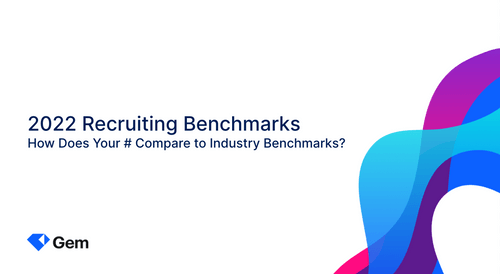
Last week Gem hosted a webinar with Amy Wood , our Senior Director of Recruiting Operations, and Danielle Belanger , Director of Talent Acquisition Operations at Toast , to talk about why benchmarks matter, share some key data points we’ve found in our research, and discuss how they can help you answer questions like:
How long should it take to hire a role based on your industry/company size?
How many applicants do you need to make one hire in a given department?
What does a good job offer acceptance rate look like?
What are average open and reply rates for prospect outreach?
What are the average conversion rates for each stage of the recruiting funnel?
How do these numbers differ by industry, department, location, gender, and race/ethnicity?
In this article, we’ve compiled key recruiting stats and benchmarks from the webinar and expert commentary from our hosts to help make sense of all the data (you can also watch the webinar here ).
Why do benchmarks matter?
It’s tough to win a race if you don’t know where the other competitors are. The same goes for recruiting. Benchmarks let you compare your organization with others, report your progress to business leaders, and set realistic goals based on data rather than gut feelings. In addition, benchmarks provide relevant context for your data, allow you to make stronger recommendations to your stakeholders, and can completely change the nature of hiring conversations.
Amy Wood: “At a past company I was running a technical recruiting team, and my hiring managers were very concerned about our (seemingly) low offer acceptance rate. However, this was because we were looking at our tech offer acceptance rate in relation to the company-wide rate. When we pulled data on offer acceptance rates for technical roles in our industry, we found that our rates were actually much better than expected.”
Where did we get our recruiting benchmark data?
To get our benchmark data, we looked at our extensive customer database. We drew data points from more than 12 million candidates who entered process and 2.2 million outreach sequences, over a period from September 2021 to March 2022.
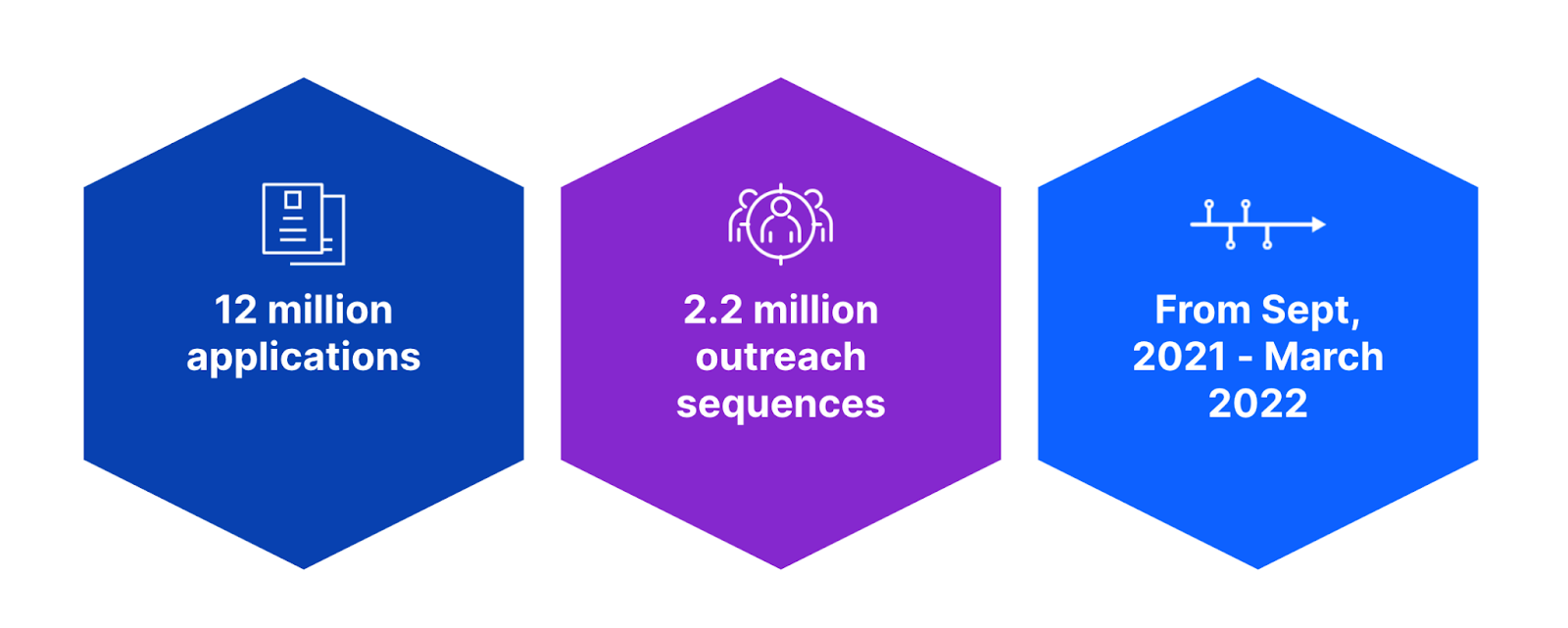
Specifically, we looked at metrics like:
Outreach stats
Time to hire
Passthrough rates.
Offer accept rates
Recruiting outreach stats
Outreach is responsible for attracting the best candidates, getting them interested in your organization, and convincing them to take an interview. For purposes of this study, we looked specifically at three-stage sequences in which a recruiter sent one initial email, InMail, etc., and two additional follow-up messages. We chose three-stage sequences because we saw the highest rate of return on these types of sequences (reply rates tend to drop off after three messages).
Outreach message open rates
The first step in tracking outreach success is looking at open rates. Across all industries, company sizes, etc., the average open rate for a three-stage sequence was 80% , a slight drop from last year’s 81% open rate. Response rates were lowest for sales and engineering roles ( 77-79% ) and highest for design and product roles ( 85% ).
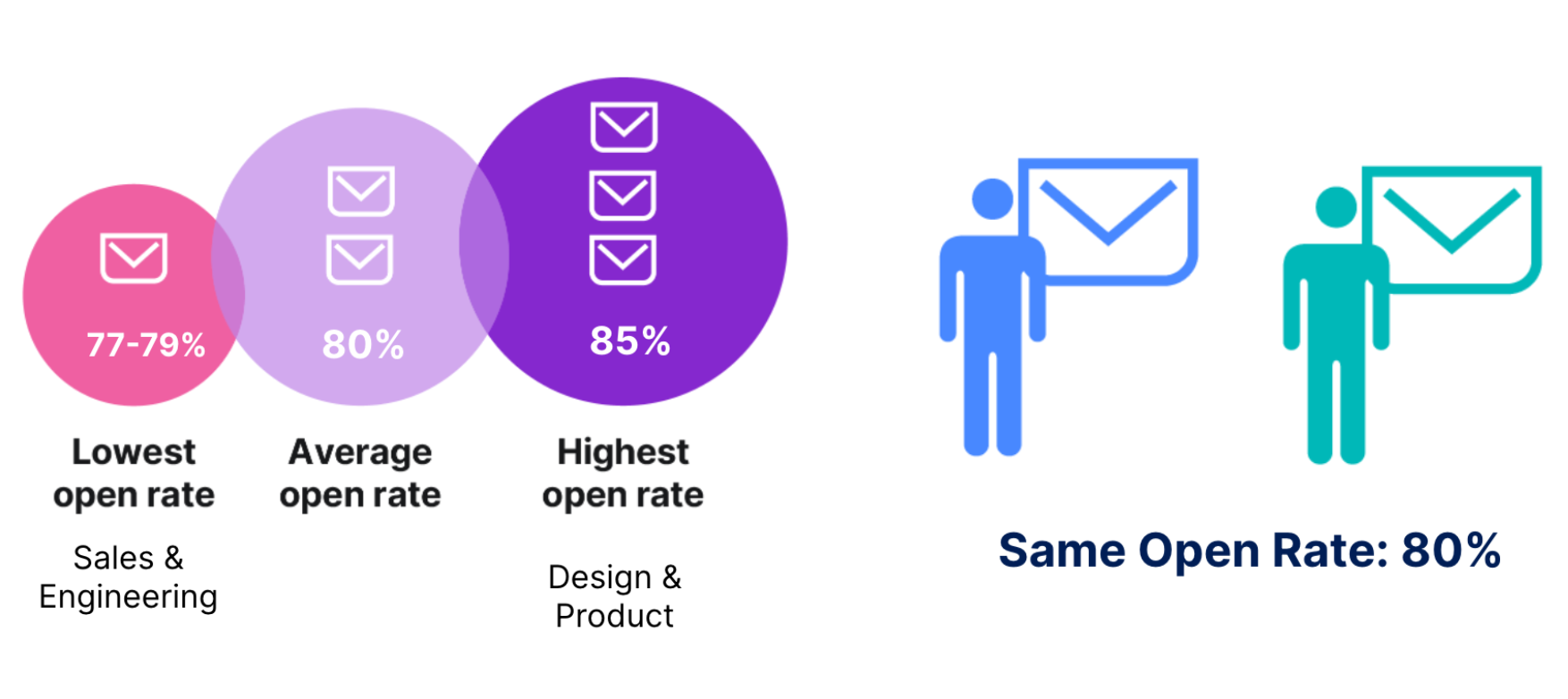
While open rates for both male- and female-identified talent were the same— 80% across the board, male-identified talent received 2.3x more outreach than female-identified talent did. The biggest volume disparity was found among engineering and eng manager roles, where email outreach was sent nearly 3x more often to male talent than it was to female talent.
Danielle Belanger: “Looking at these open rates by role, I’m not surprised that both sales & eng have the lowest rates. The competition and push for talent in these areas is huge. At Toast, we’re starting to spend more time digging into the types of outreach that drive better engagement and figuring out how to replicate that. We’re not always going to get it right on the first try, but measuring success and experimenting are our best friends here.”
Outreach message reply rates by org size
There are many factors that influence a candidate’s decision to reply to a recruiter’s outreach messages, but we’ve found company size to be a big one. The overall reply rate for outreach messages was 22% , down from 28% this time last year; however, this number varied by company size. Enterprise-level companies of 1000+ full-time employees (FTEs) had a 29% reply rate to their outreach messages. However, the reply rate dropped to 20% for mid-size organizations of 249-999 FTEs and came down to only 11% for small companies of 1-249 FTEs.
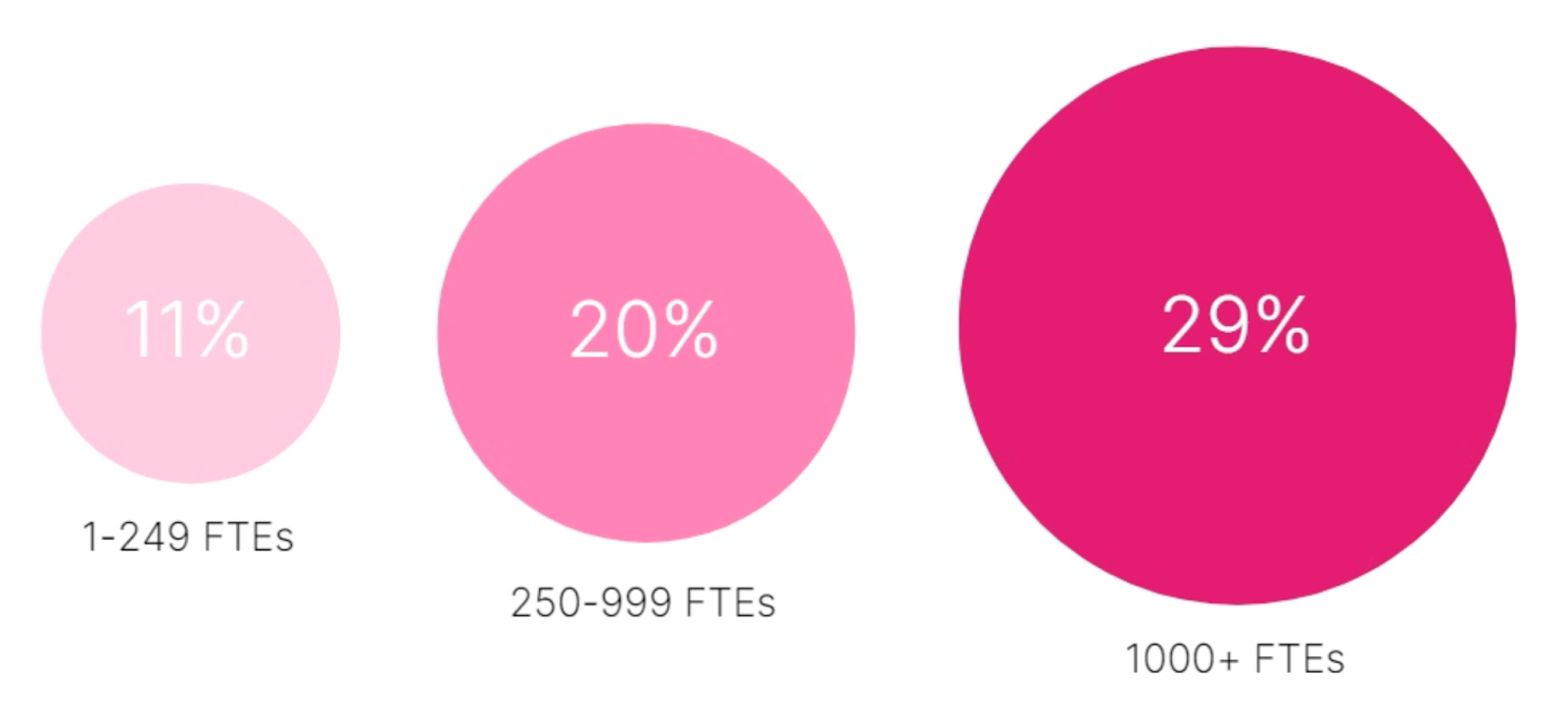
Danielle Belanger: “Decreased open rate is a sign of the competitive market. More companies, regardless of size, are investing in tools like Gem to facilitate passive outreach , so prospects are receiving more messages than ever. This means that sourcers and recruiters have to do more work to get the same number of candidates into their hiring funnels. These reply rates also show the impact talent brand can have on your recruitment strategy. Crafting personalized messages that are catered to each individual will help you stand out among the sea of outreach candidates are receiving.”
Outreach message reply rates by role and industry
Not surprisingly, reply rates have a direct correlation with open rates for outreach messages. We saw the highest reply rates among product and design roles, while we saw the lowest reply rates for sales and engineering roles. In addition, we saw the highest reply rate among FinTech companies and the lowest reply rates at Healthcare orgs.
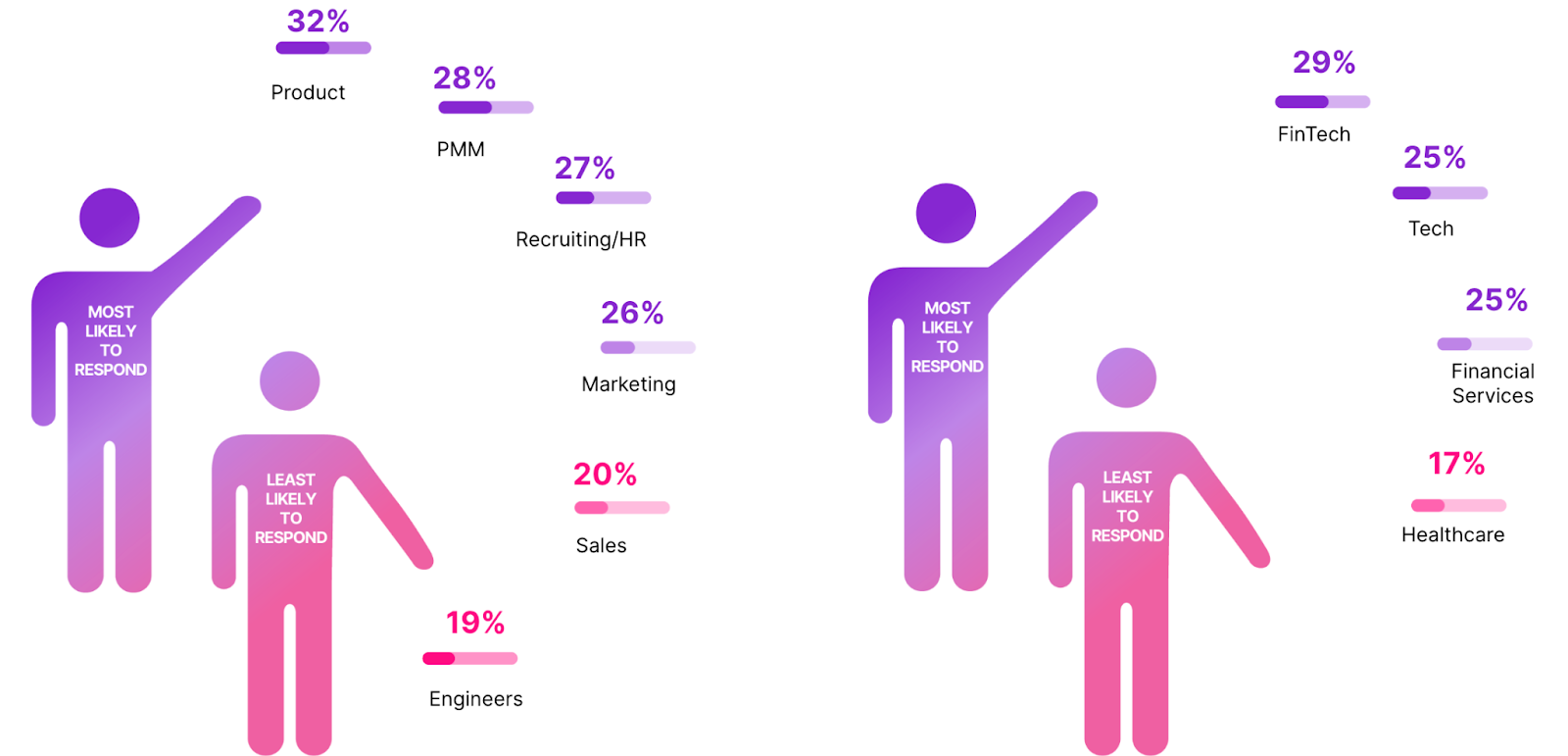
When looking at these reply rate benchmarks, keep in mind that when you’re analyzing your own data, nuances in the recruiting process—such as the type of role and industry you’re in—can play a huge part in goal-setting, capacity planning, recruiter workload, and more.
Danielle Belanger: “When sourcing for any role in any industry, it's important to factor in benchmarks when thinking about filling your pipeline with passive talent. Let's take the sales role benchmark with a 20% reply rate—if you want to bring five passive candidates to a final onsite interview next month, you should be sending outreach to 50 potential prospects in a Gem project. Setting outreach goals based on benchmarks is helpful to ensure you have the right top-of-funnel traction to reach bottom-of-funnel goals.”
Reply rates by gender
Overall we saw that women were 9% less likely to respond to emails and 12% less likely to respond to InMails than their male counterparts, even though the open rate was the same. Looking at the graph below, you’ll notice that the overall reply rate for men across all industries was actually around 29%, and the reply rate for women was 22.5%. This was due to the higher number of Engineering and Sales sequences sent by Gem users skewing the reply rates lower.
Outreach reply rate benchmarks
Email → Male 23% / Female 21%
InMail → Male 44% / Female 39%
Both combined → Male 25% / Female 23%
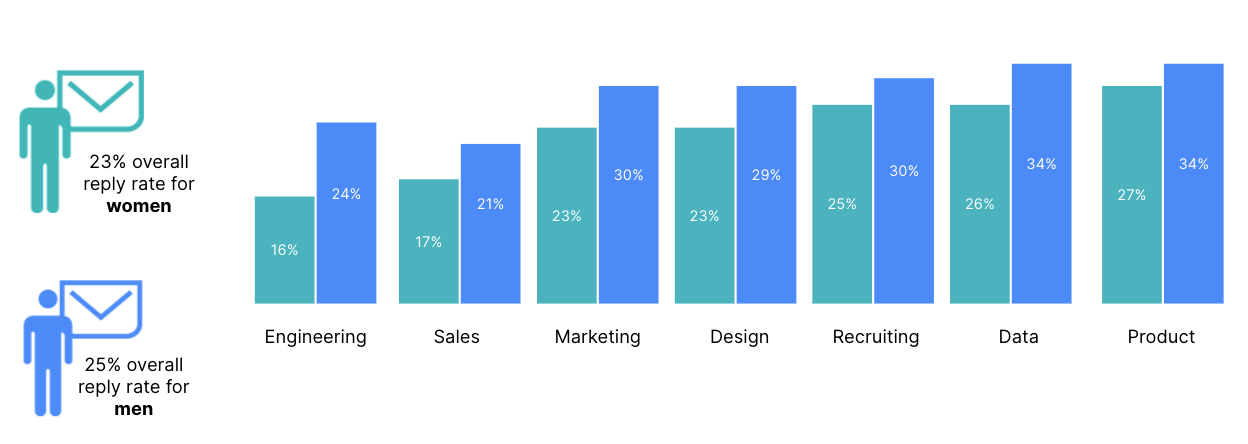
When we break things down by role and gender, we see some interesting differences in reply rates:
Engineering Manager – Women (16%) / Men (24%) → 8% difference
Data – Women (26%) / Men (34%) → 8% difference
Product – Women (27%) / Men (34%) → 7% difference
Design - Women (23%) / Men (29%) → 7% difference
Marketing – Women (23%) / Men (30%) → 7% difference
Sales – Women (17%) / Men (21%) → 5% difference
Recruiting / HR – Women (25%) / Men (30%) → 5% difference
Number of outreach messages sent
Gem customers are able to double their reply rates by sending follow-up outreach messages. One outreach message saw an 11% reply rate , two messages saw a 20% reply rate, and three messages saw a 22% overall reply rate.

Amy Wood: “One of the reasons passive sourcing is so effective is that it’s not a one-and-done strategy. As a sourcer or recruiter, you’re building relationships with each message you send. Having the right automation in place can make sending three emails to a candidate as easy as sending one.”
Time to hire looks at the number of days it takes a candidate to pass through the entire hiring funnel. The clock starts as soon as a candidate is entered into an applicant tracking system (ATS) and ends when they accept a job offer. This metric is critical because, in a competitive market, the time it takes to move a candidate through your hiring funnel can make or break their decision to accept your offer. We found that the median time to hire across all company types was 23 days , up from 18 days over the same period last year.

Comparing this data to last year, one interesting thing we found was that the time to get a candidate into the interview process (take an interview) was shorter, but the time spent in the hiring process was longer.
Danielle Belanger: “This increase in time to hire may be indicative of the human element of the recruiting process. Changing jobs/careers is a big, potentially life-changing decision for candidates—they have to weigh the pros and cons, talk to mentors, etc., to decide if it’s the right step for their career growth.
Time to hire by company size
Since last year, there have been no major changes in hiring time for small to medium-sized companies. Small companies (1-249 FTEs) saw a 21-day median time to hire, which was the same as last year, and medium-sized companies (250-999 FTEs) saw a 23-day median time to hire—down one day from last year. However, we saw a massive jump in time to hire for large organizations (1000+ FTEs) at 22 days —an eight-day increase from the same period last year.
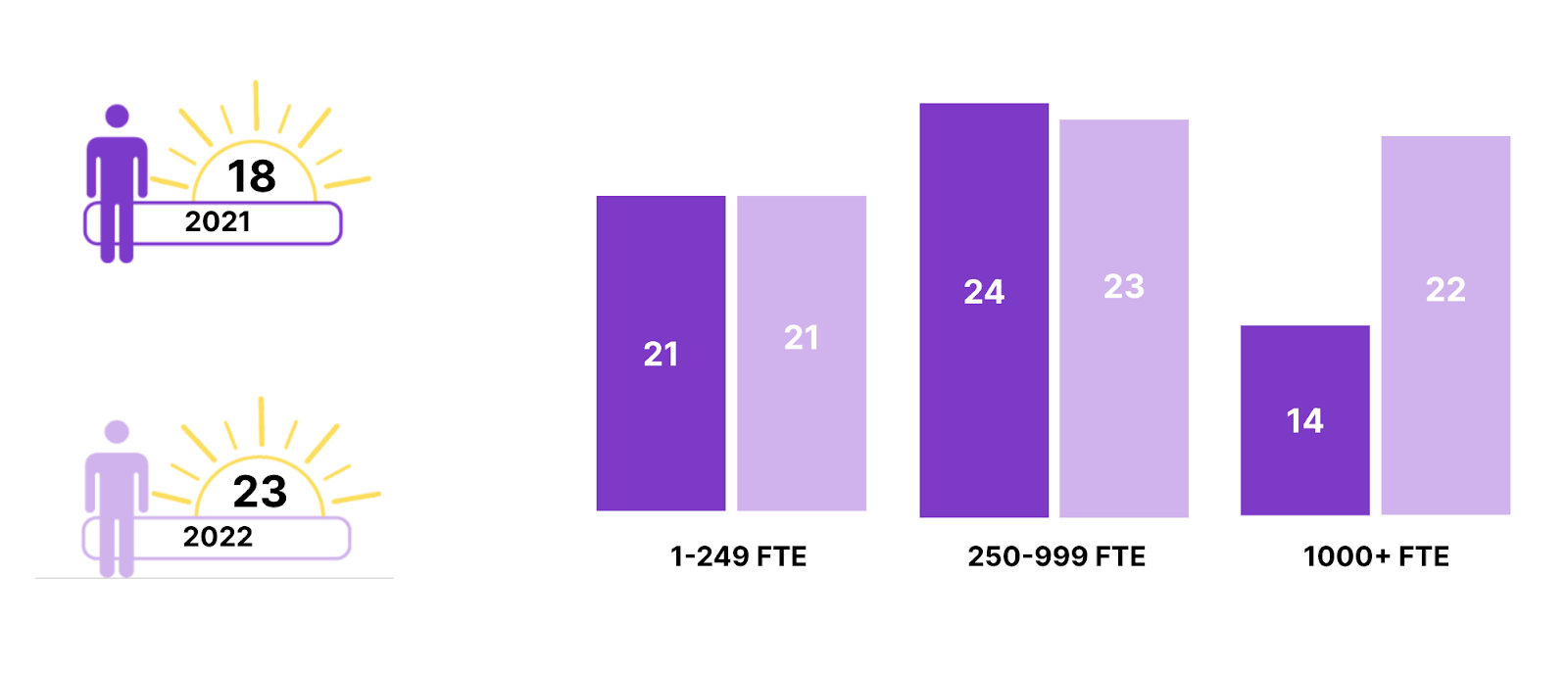
Amy Wood: “Looking at a birds-eye view of the macroeconomics, larger—and especially recently IPO’d—companies move a lot slower when it comes to hiring than small and medium-sized orgs.”
Danielle Belanger: “This is indicative of the candidate-driven market we find ourselves in. When it comes to hiring, larger organizations have lost a little bit of their competitive advantage when candidates have more opportunities than ever before.”
Time to hire by industry
When we look at median days to hire by industry, we see that time to hire in healthcare has decreased by 44% and is now only five days compared to nine last year. On the other hand, both the tech and financial sectors have seen increases in time to hire since last year. Tech is up 56% from last year, putting the median time to hire at 25 days , and finance is up 12.5% to 36 days .
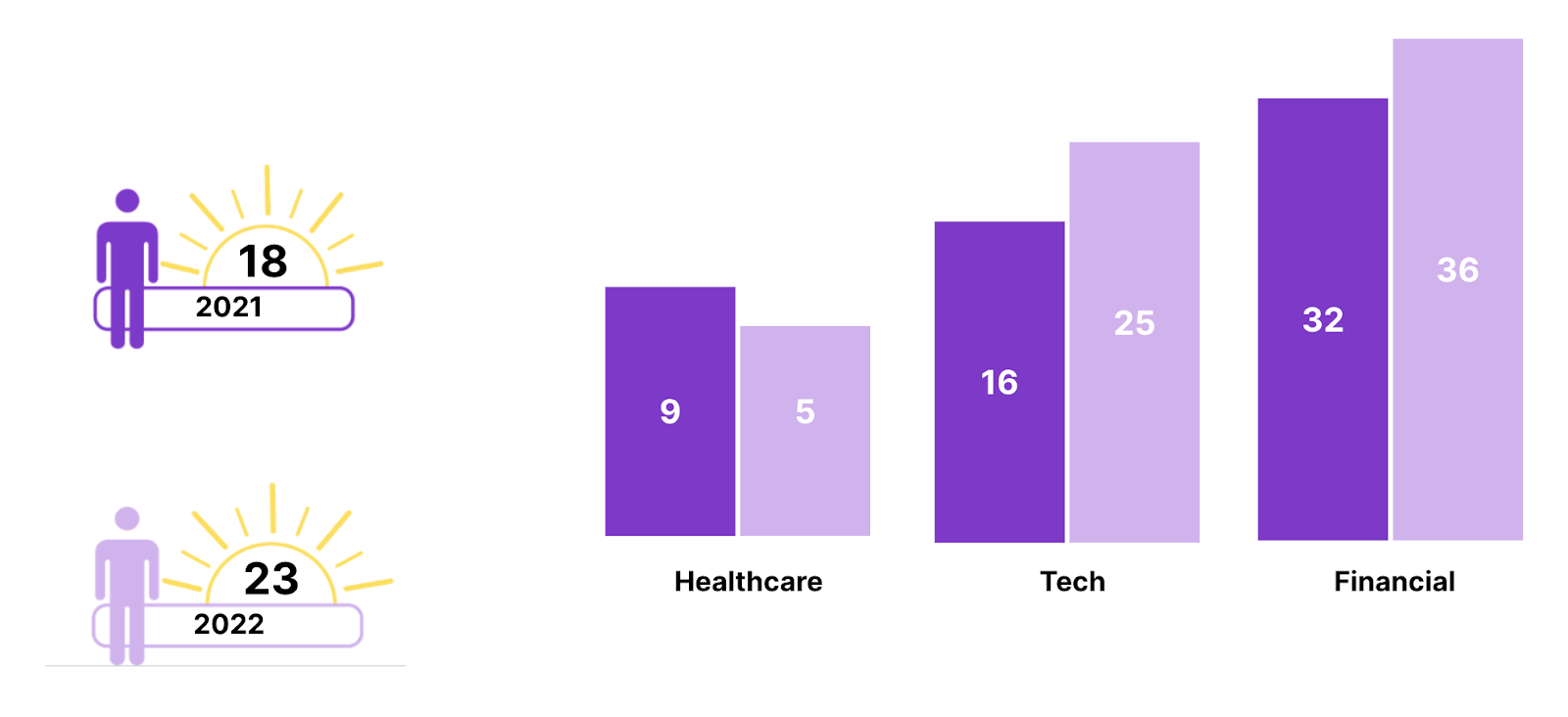
Amy Wood: “The decrease in time to hire we’ve seen in healthcare can largely be attributed to the need for essential workers over the past year. Tech and finance are likely more localized issues that have to be addressed on an individual company basis—looking at the time to hire by role, department, recruiter, etc., will allow you to identify and address where the sticking points may be in your own hiring funnel.”
Time to hire by role type
Overall, we found that technical roles (engineering, data, etc.) have a significantly higher median time to hire than non-tech roles. However, this year saw increases in both role types. The median time to hire for technical positions was 39 days , a two-day increase from the previous year, and the time to hire for non-technical roles was 20 days , a nine-day jump from last year.
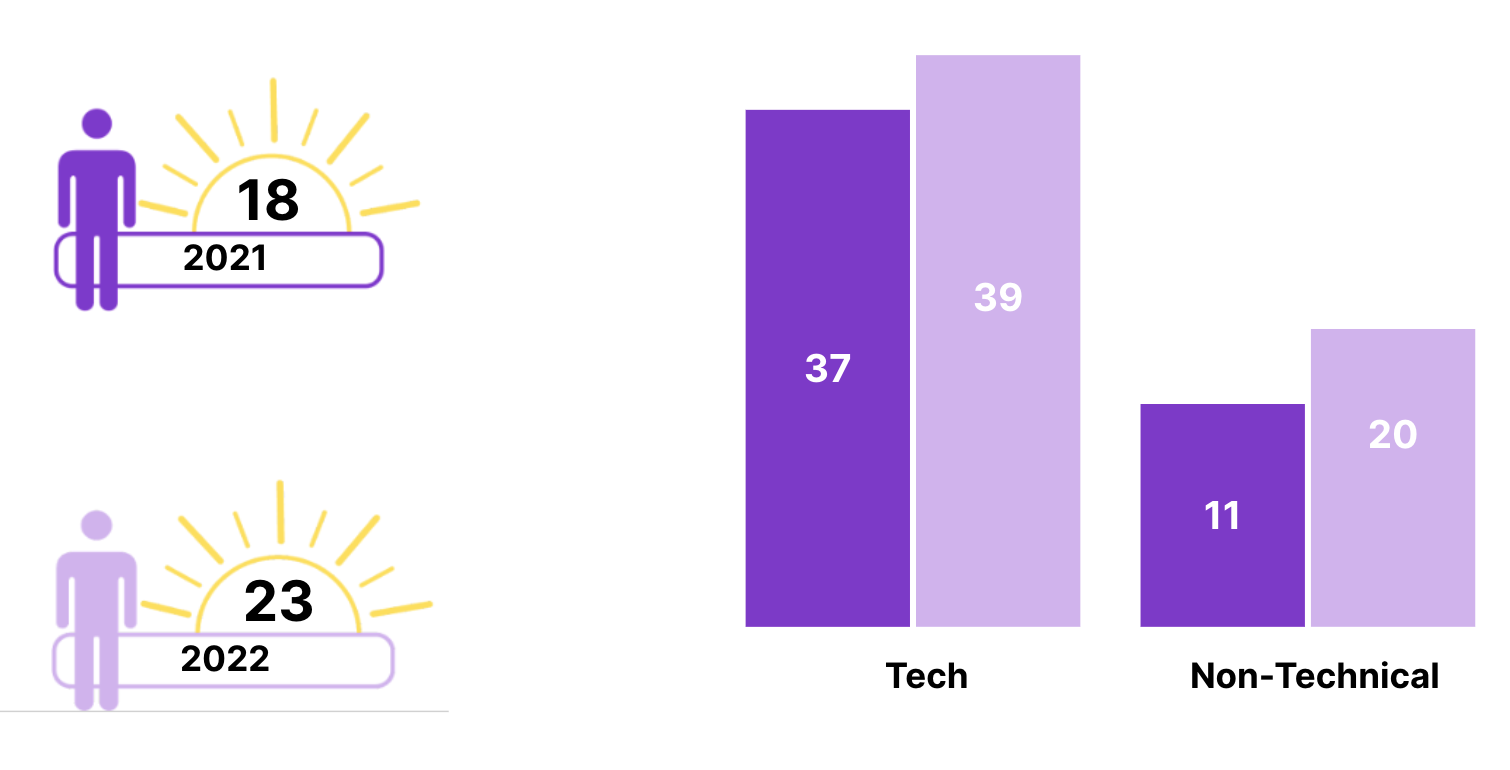
Amy Wood: “As you’re building your recruiting strategy, it’s important to think about where core processes can stay the same and where they differ—and thinking about how much longer it can take to hire a technical role could impact everything from the number of recruiters you hire, to how you plan your capacity, to the SLAs that you set with the business. Using these benchmarks is key to setting realistic hiring goals.”
Danielle Belanger: “Most organizations require one or more technical assessments, coding tests, whiteboard, etc., which will continue to drive the disconnect in time to hire between the two roles. TA leaders should take these assessments into account when capacity planning—understanding that they will inevitably slow down the hiring process, and also working to ensure they are unbiased, fair, and equitable.”
Passthrough rates are an incredibly valuable metric as they can immediately draw attention to specific opportunities to optimize your funnel. On average, we found that it takes 74 candidates to make one hire (this may seem like a lot, but this is down from 89 candidates last year). And a critical factor in bringing the number of top-of-funnel candidates down is improving your passthrough rates.
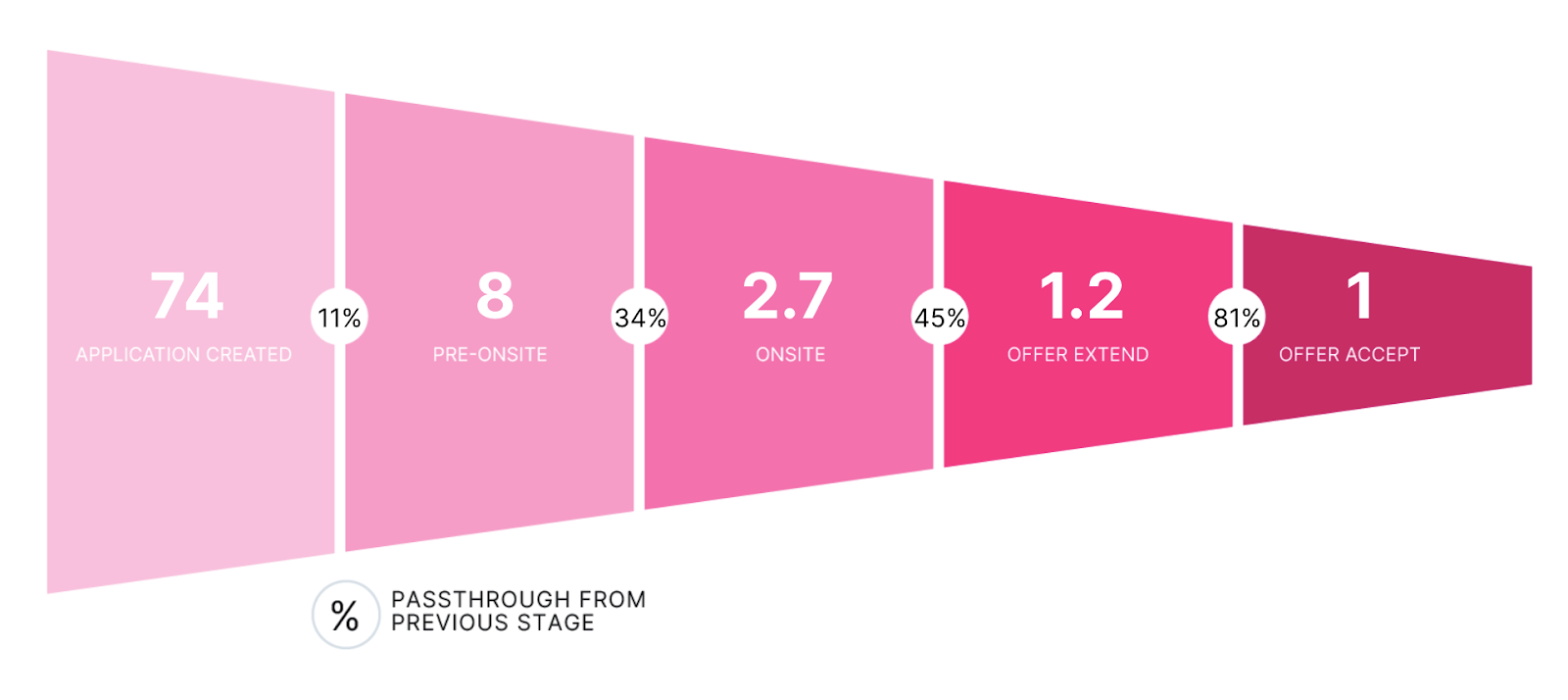
Passthrough benchmarks:
Application created: 100%
Pre-onsite: 11%
Onsite interview: 34%
Amy Wood: “When I look at these numbers at the top of the funnel, it makes me realize how important it is to build relationships and nurture your database of candidates so you aren’t starting from scratch with every new role. In the past, we’ve uncovered big opportunities to streamline the interview process when we identified stages that weren’t filtering enough folks through the funnel—this benchmark will give us all a starting point as we analyze what a “healthy” pass-through rate should be for each stage.”
Danielle Belanger: “At Toast, we use passthrough benchmarks to look at how our interview process is vetting out high-quality candidates, but we also use them in conversations around interviewer capacity and headcount planning. What does it look like when we have to hire ten people or 100 people? Do we have enough recruiters, interviewers, etc., to meet our hiring goals in the next quarter, six months, or year?”
Passthrough rates by gender
Overall, we saw 20% more men than women entering the funnel; because of this, a greater percentage of men made it to the pre-onsite stage. However, female talent passed through the funnel at greater rates than their male counterparts from after the pre-onsite stage and onwards.
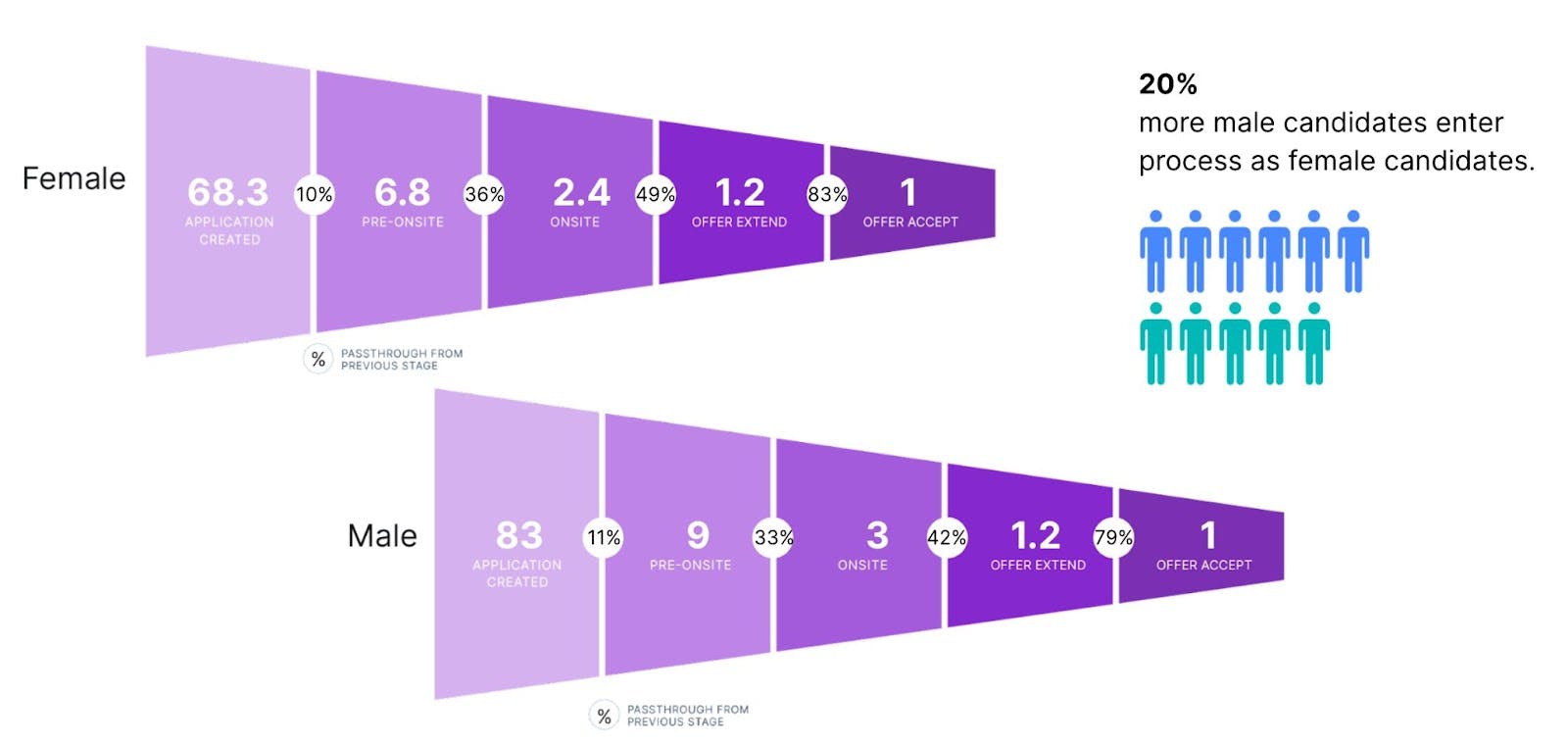
Pre-onsite: 10%
Onsite interview: 4%
Hires: 1.5%
Amy Wood: “To me, when we group this together with the reply rates for passive sourcing, it’s clear an increased focus on building a strategy for how you engage women in your funnel is really important as you would need to engage about 20% more women. I’m personally a big fan of the slate/batch interview process, which can help even the playing field when it comes to diversity in the funnel.”
Passthrough rates by ethnicity
White candidates see slightly higher passthrough rates from “application created” to “pre-onsite” ( 12% vs. 9% for Black/African-American and 11% for Hispanic/Latinx). That said, Black and Hispanic/Latinx talent see similar or even higher passthrough rates across the remaining stages of the funnel. At the same time, Asian talent has the lowest passthrough rates after the pre-onsite stage and also has the lowest offer acceptance rate.
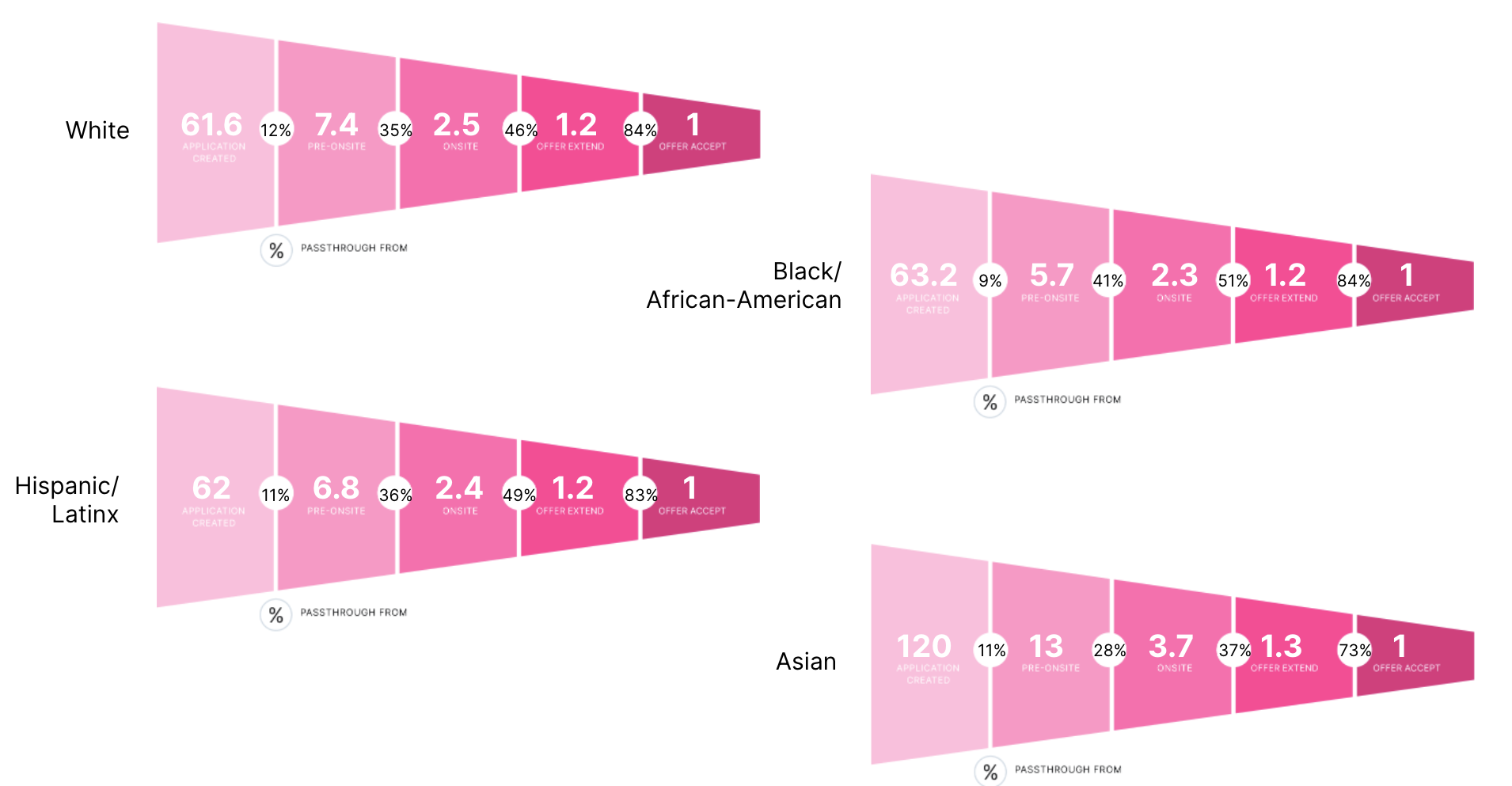
Pre-onsite: 12%
Black/African American:
Pre-onsite: 9%
Hispanic/LatinX:
Onsite interview: 3%
Danielle Belanger: “By looking at this data within your own company, you can look for signs that may indicate bias in your process that could be weeding out great BIPOC or historically marginalized candidates. You should ask yourself: Are our interview questions fair and consistent? Are our panels prepared to navigate behavioral interview questions with folks from non-traditional backgrounds (a tech role for someone who hasn’t worked in tech before, for example)? There’s a lot of action you can take here—it’s important to review and hold your TA and leadership teams accountable.”
Offer acceptance rates
In our data, we saw an average offer acceptance rate of 81% , a decline from last year’s average of 85%. Large companies (5000+ FTEs) and small companies (<250 FTEs) saw the highest offer acceptance rates; and unsurprisingly, technical roles (engineering, data, etc.) had much lower acceptance rates than non-technical roles.
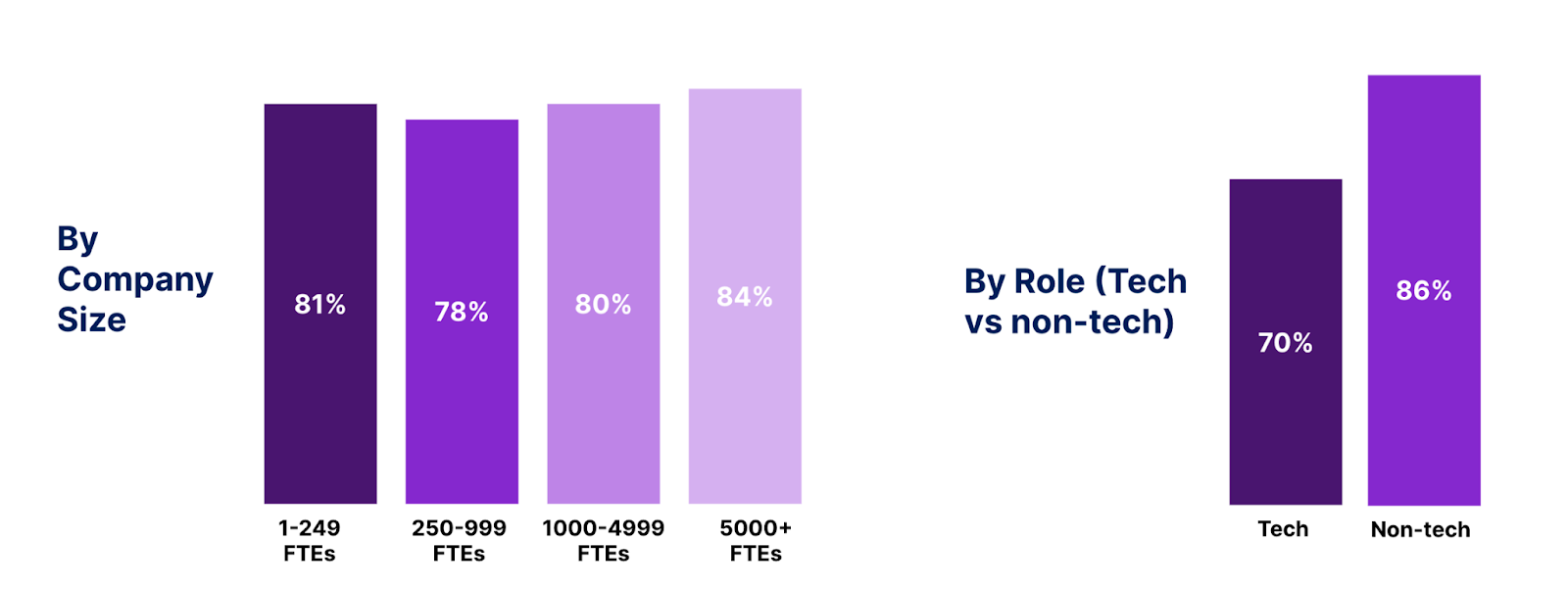
Company size:
1-249 FTEs: 81%
250-999 FTEs: 78%
1000-4999 FTEs: 80%
5000+ FTEs: 84%
Non-tech: 86%
Amy Wood: “A great way to action this data is to think about your hiring goals and expectations for recruiters and how they may vary depending on focus area. At Gem, we use these benchmarks when we think about capacity modeling for recruiters. What this data is telling us is that a tech recruiter may have to extend nearly 20% more offers to make the same amount of hires that a tech recruiter makes. Then, we think about how that may impact the input at the top of the funnel.”
Danielle Belanger: “This is critical information to share with your leadership, HR, and finance teams. For example, if you’re seeing a large percentage of offers declined due to competitive offers, it can help drive the feedback loop with information on how you can better sell the company with things like salary, benefits, etc.”
Benchmarks are the cornerstone of any data-driven hiring process. They allow you to make sense of your data, determine where you are in relation to your peers, and give you a source of truth on which you can base your hiring decisions. Gem’s Talent Compass can help you track all the benchmarks we covered in this article and many more, so if you’d like to get unparalleled visibility into your hiring funnel, schedule a demo and we’ll show you how.
Let's admit it—the current recruiting landscape is rough. But the good news is we're here to provide the benchmarks and knowledge you need to navigate these challenges and power your hiring strategies.
Benchmarks and best practices for messaging passive talent
We analyzed 10 million outreach sequences sent through Gem to bring you the 2022 “Definitive guide for recruiting email outreach,” including actionable insights for successful outreach sequences that help you stay competitive in today’s marketplace.
Related posts

July 12, 2024
How top TA teams use their existing network to find talent

June 11, 2024
Consolidate your recruiting tech stack to eliminate Franken-stack headaches

How to maximize recruiter productivity with tech that works better together
Your resource for all-things-recruiting
Looking for the latest data, insights, and best practices? Welcome to the Gem blog. We've got you covered.
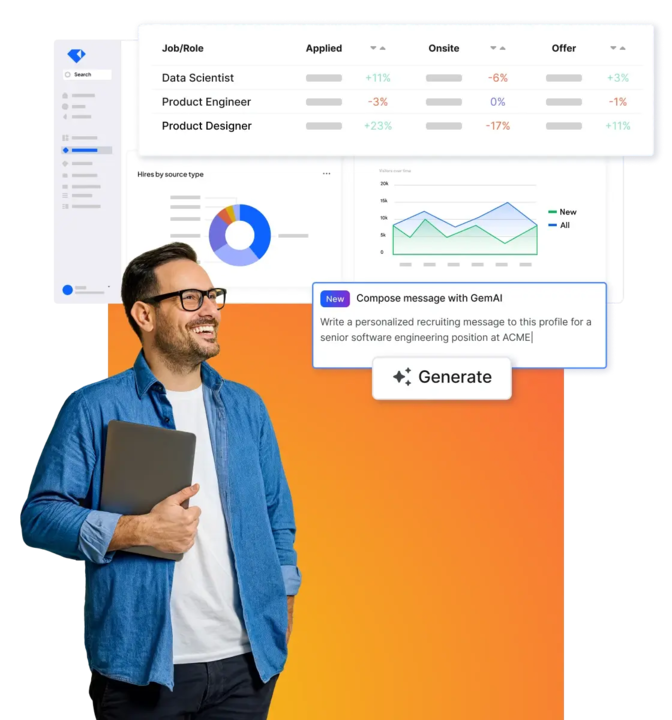
Get started today
See how Gem can help you hire with remarkable speed and efficiency
Coding interview coming up? Make sure you’re ready with our Interview Prep learning path! 💪
GET STARTED →
How to make the most of benchmarking data in your tech recruiting

It’s a deceptively simple question: Are our tech recruiting processes working? When you try to answer this question, however, you quickly realize how complex it really is. To start, what do you mean by “working?” What metrics or outcomes indicate success for your team? Then, once you’ve decided which outcomes to measure, how do you define a good versus a bad outcome? And compared to what?
This is where recruitment benchmarking data can help. In this post, we’ll define:
- What recruitment benchmarking is (and why recruiting teams need it)
- Top recruiting metrics to benchmark your tech hiring process
- How to measure the effectiveness of your technical assessments
What is recruitment benchmarking?
Recruitment benchmarking is the process of measuring an organization’s recruitment performance against the practices and results of other companies within the same industry. It involves assessing key recruitment metrics such as time-to-fill, quality of hire, and cost per hire, among others, and comparing them with industry standards or competitors’ data. By leveraging this comparative analysis, companies can identify gaps in their recruitment strategies and make informed decisions to improve their processes. It offers insights into the effectiveness of an organization’s recruitment tactics and provides a guideline for what constitutes good performance in a specific industry context.
Why hiring teams should use recruitment benchmarking
Recruitment benchmarking can reveal valuable insights about market trends, innovative practices, and competitive advantages . For instance, if your company’s time-to-hire metric is significantly longer than the industry average, this could indicate inefficiencies in their recruitment process that need to be addressed: Does your company have too many rounds of assessments and interviews in your process? Is there a slowdown or bottleneck at any particular stage of your process? Understanding where you stand relative to your competitors allows your hiring teams to set realistic targets, prioritize improvements, and track progress over time. To make this easier, hiring teams can visualize this data using dashboards, which make patterns and trends simpler to identify.
What recruiting metrics should we track?
To do recruitment benchmarking, you’ll first need to decide which metrics you want to track and benchmark against. Here are the top recruiting metrics we recommend tracking—including what information you gain from each:
Candidate volume
Candidate volume is simply counting the number of applicants for a job opening—both those who come in by themselves (inbound) and those you reach out to (outbound). To benchmark this, you need to keep a track of the number of applications received for similar roles in the industry and compare it with your numbers.
Measure candidate volume if you want to: understand the success of your sourcing and talent marketing efforts. It’s also useful for estimating candidate volume further down the funnel: number of screening interviews, number of onsite interviews, etc.
Interviewing time spent on unqualified candidates
The interviewing time spent on unqualified candidates metric is all about the hours your hiring team spends on candidates who aren’t a good fit . This may involve resume reviews, grading take-home projects or coding challenges, and live interviews. You can benchmark this metric by conducting a time study of your recruitment processes and comparing the results with industry standards.
Measure interviewing time spent on unqualified candidates if you want to: gain buy-in from the hiring team for recruiting tools like screening assessments that ensure only qualified candidates are passed along to the interview stage.
Onsite-to-offer
The onsite-to-offer rate tells you what proportion of your onsite interviews lead to a job offer. Remember, this doesn’t tell you if the candidate says yes to the offer. It’s important to track because it gives you a measure of the quality of candidates reaching the onsite interview stage. You can benchmark this metric by comparing your ratio with industry norms to see if you’re on track.
Measure onsite-to-offer rate if you want to: better understand the quality of candidates making it through to the onsite. A high onsite-to-offer rate suggests your process is effective at screening for qualified candidates at the top of the funnel.
Time-to-fill
Time-to-fill describes the duration it takes from posting a job to onboarding a new hire. It is often measured by the number of days between publishing a job opening and hiring a candidate. To benchmark this metric, look at industry standards and competitor data, and compare your time to fill to see how you’re performing.
Measure time-to-fill if you want to: improve your ability to set and deliver on realistic headcount goals.
Candidate drop-off
Candidate drop-off is all about how many candidates choose to leave the recruitment process at any stage. If you’re using technical assessments, this metric refers to the number of candidates who complete an assessment compared to those who were invited to take it. To benchmark this, look at the drop-off rates of similar roles within the industry and see how your rates compare.
Measure candidate drop-off if you want to: measure candidate experience throughout your hiring process.
Cost per hire
Cost per hire is calculated by adding up your recruitment expenses for a specific period (such as a quarter) and dividing it by the number of hires you’ve made during that time. To benchmark this, compare your cost of hire with industry averages or the average cost per hire at similar companies.
Measure cost per hire if you want to: calculate and forecast your recruiting budget given the number of roles your team needs to fill.
Quality of hire
Quality of hire can be tricky to measure, but it’s an essential metric. Quality of hire measures how well a new hire performs, usually in their first year. You can benchmark this metric by comparing the first-year performance ratings of your new hires with industry averages or the average performance ratings of new hires at competitor companies.
Want to get a sense of quality of hire before the one-year mark? Assessment scoring benchmarks provide an early indicator of the quality of your candidate pool, allowing you to optimize for quality of hire early in the recruiting process.
Measure quality of hire if you want to: answer the question, “is recruiting bringing in the right talent?”
How can we measure the effectiveness of our tech recruiting?
Here at CodeSignal, we’ve helped countless hiring teams evaluate and improve their technical hiring processes using funnel analysis. Funnel analysis , in the context of recruiting, refers to the examination of various stages in the recruitment process to identify potential bottlenecks or points of candidate drop-off.
Similar to a sales or marketing funnel, a recruiting funnel has several stages, typically starting with sourcing candidates , administering assessments , conducting interviews, and finally making job offers. By analyzing how many candidates progress from one stage to the next, hiring teams can gain insights into the effectiveness and efficiency of their recruitment process. Paired with benchmarking data, funnel analysis is a powerful way to evaluate the success of your tech recruiting process—from sourcing to hire.
We’ve launched CodeSignal Analytics to help companies do just this by providing data dashboards and insights to build, measure, and optimize an industry-leading tech hiring process that bolsters their bottom line.
With CodeSignal Analytics, you get:
- Savings quantified: Realize and quantify the amount of time and money your organization is saving, substantiating your ROI.
- Refined hiring metrics: Track and improve your hiring process with the ability to measure key metrics like time-to-hire and cost-per-hire.
- Efficiency unleashed: Gain valuable visibility into key process stages to identify and address bottlenecks where candidate drop-off exceeds benchmarks, ultimately boosting efficiency.
- Quality assurance: Ensure your talent pipeline meets key standards by comparing your score distribution, skill proficiency, and more with industry peers.
- Volume management: Regulate your interview volume effectively with insights into how scoring thresholds impact your candidate pass-through rate.

Get started with CodeSignal Analytics
Want to learn more about building a data-driven tech recruiting process with CodeSignal’s end-to-end tech hiring solutions? Contact your CSM or schedule a call with one of our experts.
%20-200x43.png)
Recruiting Analytics
Access and share all core recruiting KPIs in real-time.
Quality of Hire Analytics
Connect pre-hire decisions with post-hire performance for Quality of Hire insights.
360 Reference Checking
Transform reference checks into powerful candidate intelligence.
Surveys & Listening
Listen at scale, improve candidate, hiring team and new hire experiences.
TalentWall™
An engagement layer for your ATS to streamline pipeline management, stakeholder collaboration, and hiring analytics.
Hiring Intelligence Platform
Tools and insights designed to optimize all aspects of the hiring process.
Partners & Integrations
Explore our partner ecosystem.
Quality of Hire Model
The science behind calculating Quality of Hire
BY BUSINESS OBJECTIVE
Quality of hire.
How do I reliably measure Quality of Hire?
Recruiting Metrics
How can I see my core recruiting KPIs?
Pipeline Health & Plan Attainment
How can I predict if we will hit our hiring plan?
Candidate Experience
How can I better understand our candidate experience?
FEATURED PARTNERS
Crosschq for Workday
Crosschq for sap, crosschq for greenhouse.
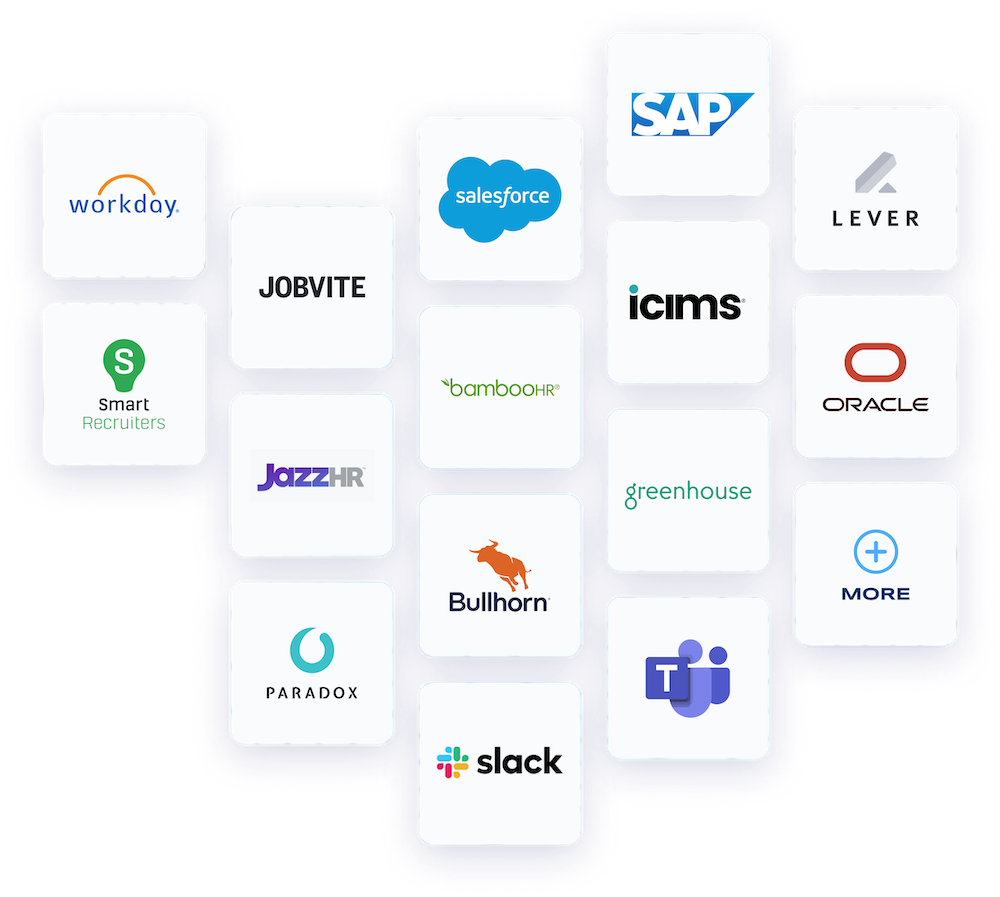
Read up on the latest Hiring Intelligence posts
Dive deeper with the latest research and guides
Explore our help articles or get in touch with our support team
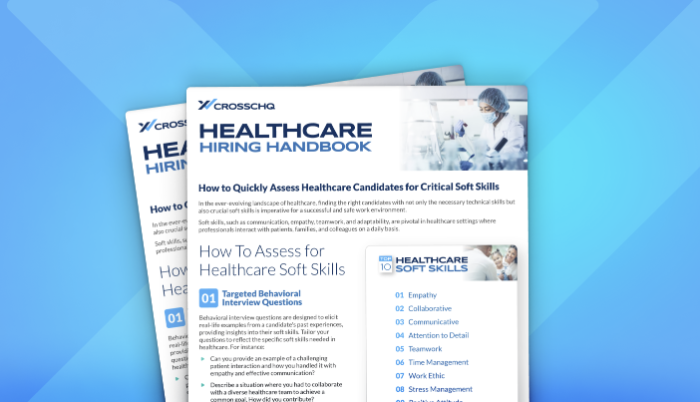
Learn about the Crosschq mission
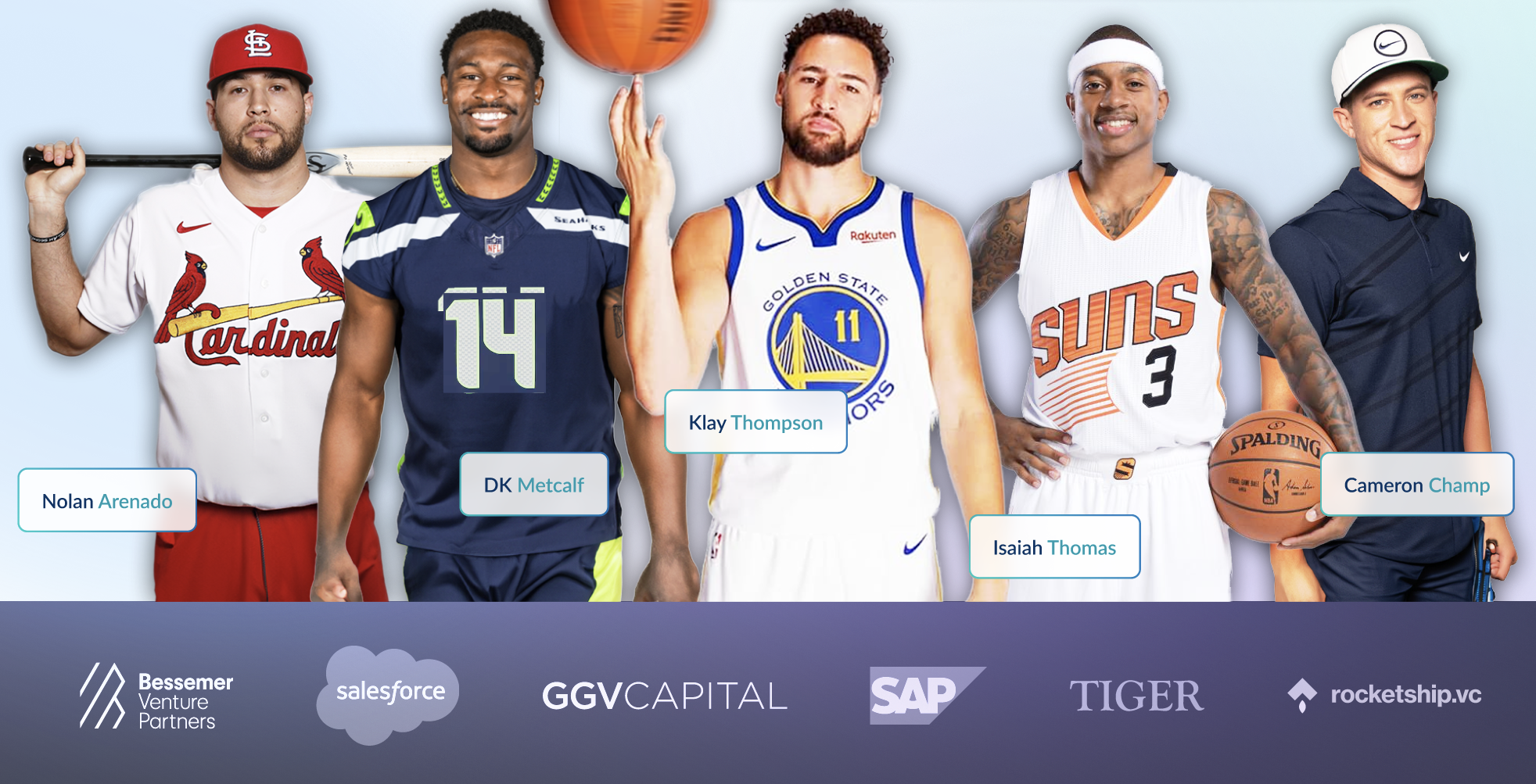
Check out Crosschq's All-Star Investors

See our latests recognized awards
Read company announcements

- ORGANIZATIONS

4 Recruiting Benchmarks to Focus on in 2023 and Why They Matter
By elena arney.

Recruiting is like any other business operation: without benchmarks, you can’t track progress or identify issues. Recruiting benchmarks can both help improve hiring strategies and elevate Quality of Hire .
Wondering why recruiting benchmarks matter? Your competitors are already leveraging these metrics to improve candidate experience and quality of hire. Here’s why recruiting benchmarks need to be at the top of your organization’s priority list in 2023.
Basic Benchmarking Rules
To be useful, a benchmark needs to establish a baseline for a metric that:
- Is able to be continually updated with new data
- Can be easily measured and compared over time
- Is capable of providing insight into specific outcomes
- Can be acted on to improve those outcomes
No benchmark means you do not have a way to measure incoming data and figure out what is or isn’t working. Choosing and using specific recruiting benchmarks can mean the difference between a scattershot approach to hiring, and a clear, well-thought-out direction for your recruiting team that includes better pipeline management .
Top Recruiting Benchmarks 2023
Many recruiting benchmarks are already well known and being used by companies with a solid recruiting strategy and a functional hiring pipeline. Important metrics include:
1. Time to Hire
How long it takes to hire for a role has been an important recruiting benchmark in 2022 as the hiring landscape fluctuated wildly, and it will continue to do so in 2023. Top talent went from battling it out just to get an interview to disappearing from the market in ten days or less .
Candidates became more demanding in regard to their recruitment experience, and less patient when it came to waiting for news on the status of their application. Three out of five recruiters reported routinely losing top talent to competitors because of slow and poorly managed hiring processes.
Hiring managers and recruiters both discovered it was critical to get on the same page to make hiring pipelines run faster and more smoothly, and turned to recruitment technology for help. Tools like Crosschq 360 , for example, help to speed up and streamline the reference-checking process, delivering informative results to help assist with data-driven hiring decisions.
Benchmarking time to hire is actually fairly simple: it’s the time period between the date when an applicant enters the hiring pipeline and the date they accept an offer. It’s a more specific metric than time to fill, which is the time period between the date of job requisition and the date of job acceptance.
Why Benchmarking Time to Hire Is Important:
Benchmarking time to hire is a critical part of understanding:
- Which empty roles are costing your organization the most money
- What talent is most in demand and hard to secure
- Where roadblocks may exist in your hiring pipeline
Time-to-hire benchmarking gives you the opportunity to examine how time to hire differs between role levels and departments, and how changes in your recruitment strategy can improve your speed-to-hire metrics.
Using a pipeline management tool like TalentWall™ by Crosschq that overlays your ATS makes it easy to visualize and track time to hire in real-time across all open positions and candidates.
2. Pass-Through Rates
Pass-through rates are another crucial metric to benchmark in 2023. They give you specific data about how your hiring funnel is performing. You can break out pass-through rates into various phases of the recruitment pipeline:
- Candidate application
- Pre-interview (pre-hire assessments, tests, and reference checking)
- Initial interview
- Second interview (if applicable)
- Offer extended
- Offer accepted
The pass-through rate isn’t as simple as any set number or percentage at each stage and can vary dramatically by department and role.
For some positions, multiple applications may be received, but your applicant tracking system (ATS) will weed lots of them out before moving the remaining candidates to the pre-interview phase. Other positions may only yield a few applicants due to specialized skill sets or experience demands, meaning most or all advance quickly to later phases in the recruitment funnel .
On the candidate experience side, benchmarking pass-through rates can reveal where candidates are self-selecting out of the process:
- Some candidates may opt out of doing a large number of pre -hire assessments and tests and pursue other opportunities instead.
- Other candidates may choose not to continue the process because the time-to-interview interval is too lengthy.
On the recruitment side, benchmarking pass-through rates can reveal how unconscious bias is eliminating top talent from the running in two significant ways:
- Unconscious bias can cause substantial and unwarranted drop-off at the pre-hire and interview phases
- Unconscious bias can have a direct and negative impact on DEIB initiatives .
Low pass-through rates can be appropriate in some cases, and high pass-through rates may be a sign that screening processes are not working as desired. For example, a high pass-through rate from pre-interview status followed by a very low pass-through rate from the interview phase can indicate a disconnect between the recruiter and the hiring manager on the profile of a qualified candidate.
Why Benchmarking Pass-Through Rates Is Important:
Benchmarking pass-through rates can give you a clear picture of where in your recruitment pipeline you may be losing candidates unnecessarily, or where unqualified or unsuitable candidates may be getting through and using up valuable time and resources.
Ideally, the right candidates will be passing through the pipeline quickly and easily, increasing the chances of a successful hire, while unqualified candidates will be swiftly but gently rejected or will self-select out of the process early on.
3. Quality of Hire
Universally recognized as the most critical recruiting benchmark for 2023, Quality of Hire is possibly one of the hardest metrics to benchmark and the most valuable in terms of helping your organization hire top talent .
Quality of Hire , in a nutshell, is a way to quantify the value a new hire brings to the company. Performance and retention are two of the most important factors for this metric, but it can also include culture add , engagement, promotability, and re-hireability.
In an ideal situation, recruiters and hiring managers will be able to use data previously gathered on existing employees to benchmark Quality of Hire and develop a profile that describes a quality hire. This profile can be used to swiftly surface the best candidates in the hiring pipeline and nurture them through the process.
Crosschq’s Quality of Hire Scorecard can be helpful in benchmarking your organization’s Quality of Hire, while more than 80 reports designed to deliver Quality of Hire insights are available through Crosschq Analytics .
Why Benchmarking Quality of Hire Is Important
Benchmarking and tracking Quality of Hire can not only help you accurately identify candidates with high Quality of Hire potential but can help you make better decisions around layoffs by ensuring you keep the best employees in place and let lower quality ones go, instead of depending on outdated “last-in, first-out” traditions. Download our free Quality of Hire report to learn more.
4. Candidate Experience
Finally, candidate experience cannot be ignored when establishing recruiting benchmarks for 2023. How your candidates experience your organization through the framework of your hiring pipeline can significantly affect public perception of your company.
Candidate experience can be critical to keeping top talent in the pipeline at critical points in the pipeline. An application or assessment process that is time-consuming, complicated, and burdensome will turn off many employees who would be great additions to your workforce. Additionally, many pre-hire assessments aren’t necessarily good predictors of post-hire performance.
Time to interview is another key pain point for candidates; if an interview isn’t forthcoming soon after it was promised, candidates may assume they have been “ghosted” and will abandon the hiring funnel completely. A fast, efficient interview scheduling process is critical when trying to land a high-quality candidate .
Ultimately, candidate experience hinges on an easy-to-complete, intuitive application process and constant communication throughout the hiring period. Nurturing should be a standard part of any recruitment strategy, with a focus on making sure even “also ran” candidates look back on their experience as a positive one.
Candidate experience doesn’t just serve candidates and enhance your organization’s reputation. Organizations that invest in a strong candidate experience report they can improve the quality of their new hires by 70%.
Why Benchmarking Candidate Experience Is Important
Eight out of ten candidates say good communication can turn a mediocre candidate experience into a great one. Candidates who have great experiences will not only be more likely to accept an offer, but will encourage other highly qualified people to apply. Even silver medalist candidates who almost make the cut are rejected, a great candidate experience will make them receptive to applying again in the future.
Recruitment Benchmarks For 2023 With Crosschq
Once you begin benchmarking your recruitment metrics, you’ll be able to surface and leverage insights to enhance your hiring funnel, improve pipeline management, align your recruiters and hiring managers, and give your candidates a superior candidate experience. All of this leads to the ultimate outcome: hiring the best person for the job, every time.
To learn more about how Crosschq can help your organization utilize recruitment benchmarking to achieve core business outcomes in 2023, request a demonstration today .
Newsletter Sign Up

Director of People & Culture
Take the Guesswork Out of Hiring

The Ultimate Hiring Benchmark Report
Tl;dr video:.
Recruiting metrics benchmarks that include the gig economy
The freelance gig economy is here to stay but recruiting metrics benchmarks regarding this elusive, on-demand industry have remained unclear. It’s been over 10 years since the first key players of the gig economy took to the market – first Airbnb in 2008, then Uber in 2009 and Lyft in 2012. Not only did this dramatically change the market landscape but also the global workforce. Today, the on demand economy is nearing $57 billion annually !


Recruiting industry benchmarking report for today’s landscape
Now, over a decade after the birth of the on-demand industry, seventy-eight million people, or 59 % of the workforce, are hourly workers. Companies still using pre-2008 hiring tactics are experiencing serious challenges. They are unable to hire qualified workers quickly enough or unable to source candidates efficiently. The reason for this is that companies don’t realize that they are now competing for the same candidate pool. Today’s job seekers have more job opportunities to choose from. With the proliferation of technology, job seekers now also have more ways to apply for these jobs, and these recruiting metrics benchmarks show this. The days of “now hiring” signs and paper resumes are becoming a thing of the past and pose as the costliest bottleneck for hiring.
[Read more: The Rise of the New Service Economy and What it Means for Your Business ]
Recruitment industry benchmarking report: What you’ll find
The new recruitment industry benchmarking report that offer new insight into the hiring practices of the largest on-demand companies
In November of 2018, Fountain published the Modern Hiring Guide which gathered all the data we collected on the major hiring trends, recruiting metrics benchmarks, and put together a battle plan for businesses to prepare for hiring in today’s landscape.
We’ve now gone a step further and are presenting the first-of-its-kind look at hard data on the fastest-growing companies – The Ultimate Hiring Benchmark Report . The on-demand industry and gig economy has redefined company growth is based on their ability to automate their hiring process. By transforming traditionally manual tasks into automated tools, on-demand companies have turned an operational bottleneck into the fuel that drives their growth.

Recruiting metrics benchmarks are meant to answer useful questions about your business and help you understand how you compare. The problem is, however, how are other businesses able to compete with these large, on-demand companies who hire so effectively when they don’t know how they measure up?
This is where The Ultimate Hiring Benchmark Report comes into play. Our goal is to provide you with a cohesive look at the industry leaders in the on-demand industry, as well as the relevant recruiting metrics and benchmarks that you care about. Our focus is the on-demand industry because the way in which they have redefined company growth is based on their ability to automate their hiring process. By transforming traditionally manual tasks into automated tools, on-demand companies have turned an operational bottleneck into the fuel that drives their growth. We want to share their tactics so that you can increase your hiring efficiency and compete effectively for the same, hourly labor pool.
The metrics included in this recruiting industry benchmarking report were gathered from Fountain’s internal data on some of the fastest-growing on-demand companies like Lime and Deliveroo . The industries vary, but all of these companies share the same business goals: they offer direct-to-consumer services and rely on hourly workers as the backbone of their business model.
How to Hire for Small Businesses Who Plan on Growing in Less Than a Year
Our recruiting metrics benchmarks are unique to businesses that rely on hiring hourly workers, are looking to hire faster, or are trying to scale their workforce quickly and efficiently. As a result, this recruitment industry benchmarking report is meant to be used by businesses looking to compare their metrics to the industry leaders and learn how to improve their own efforts.

What the Recruitment Industry Benchmarking Report will give you:
- A look at the top hiring metrics and how the on-demand companies are performing
- What strategies these companies are using to get such a high number of applicants and low time-to-hire
- Practical recommendations on how to make your hiring funnel more efficient.
Get The Ultimate Hiring Benchmark Report for the full, in-depth analysis!
Ready to take the next step in dramatically improving your hiring process and cutting your hiring costs? Contact the Fountain team for a demo and increase your hiring efficiency by 400%. See why Fountain is the recruitment software of choice for companies like PICKUP and Deliveroo .
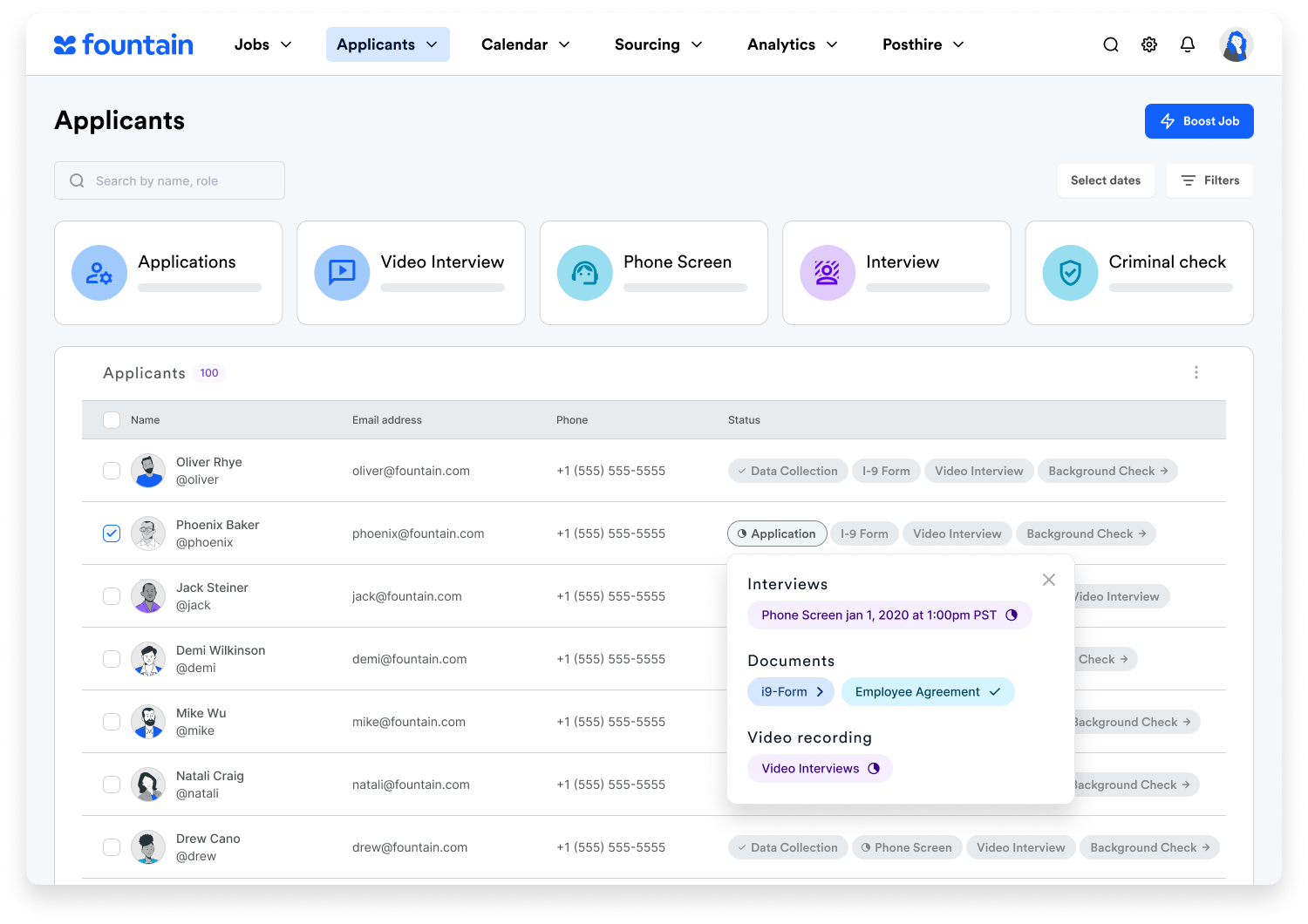
Enter a new era of frontline workforce management.
Learn more about how Fountain Hire can help you transform frontline recruiting, onboarding, and retention for improved workforce management.
About the Author
Related content, what is recruitment process outsourcing, redefining rpo: how can the new model elevate your frontline hiring, fountain is now available on the sap® store.
Skills-based success: 10 recruiting case studies

The working world has been turned on its head with the pandemic, the Great Reshuffle, and the resulting skills shortage. Companies are searching for a powerful, sustainable way to recruit and retain talent, and 81% of them are now opting for skills-based hiring practices.
Skills-based recruitment practices are for everyone. Don’t believe us? We've put together 10 recruiting case studies that demonstrate how different individuals, industries, and regions have successfully implemented skills-based hiring.
Table of contents
What's the purpose of a recruiting case study, 3 personal recruiting case studies, 3 recruiting case studies by industry, 4 recruiting case studies by region, looking for more recruiting case studies, the state of skills-based hiring 2024.
Read TestGorilla's annual report to discover why over 81% of companies are choosing to adopt skills-based hiring methods in 2024.

In recruitment, case studies are helpful tools for employers seeking to build, develop, or optimize their recruitment processes. They can be great sources of information and inspiration. By understanding the successes and failures others have had with their hiring processes, hiring managers can take any relevant learnings without having to make the same mistakes that others have.
To make these recruiting case studies relevant for as many people as possible, we've divided them into personal case studies, case studies by industry, and case studies by region. Let's dive in.
Let’s first look at the personal stories of some stellar individuals who were recruited into their ideal industries using skills-based practices. These people didn’t have traditional backgrounds, but because of their unique skills, they got into amazing roles. All that was needed was a chance to prove those skills during recruitment.
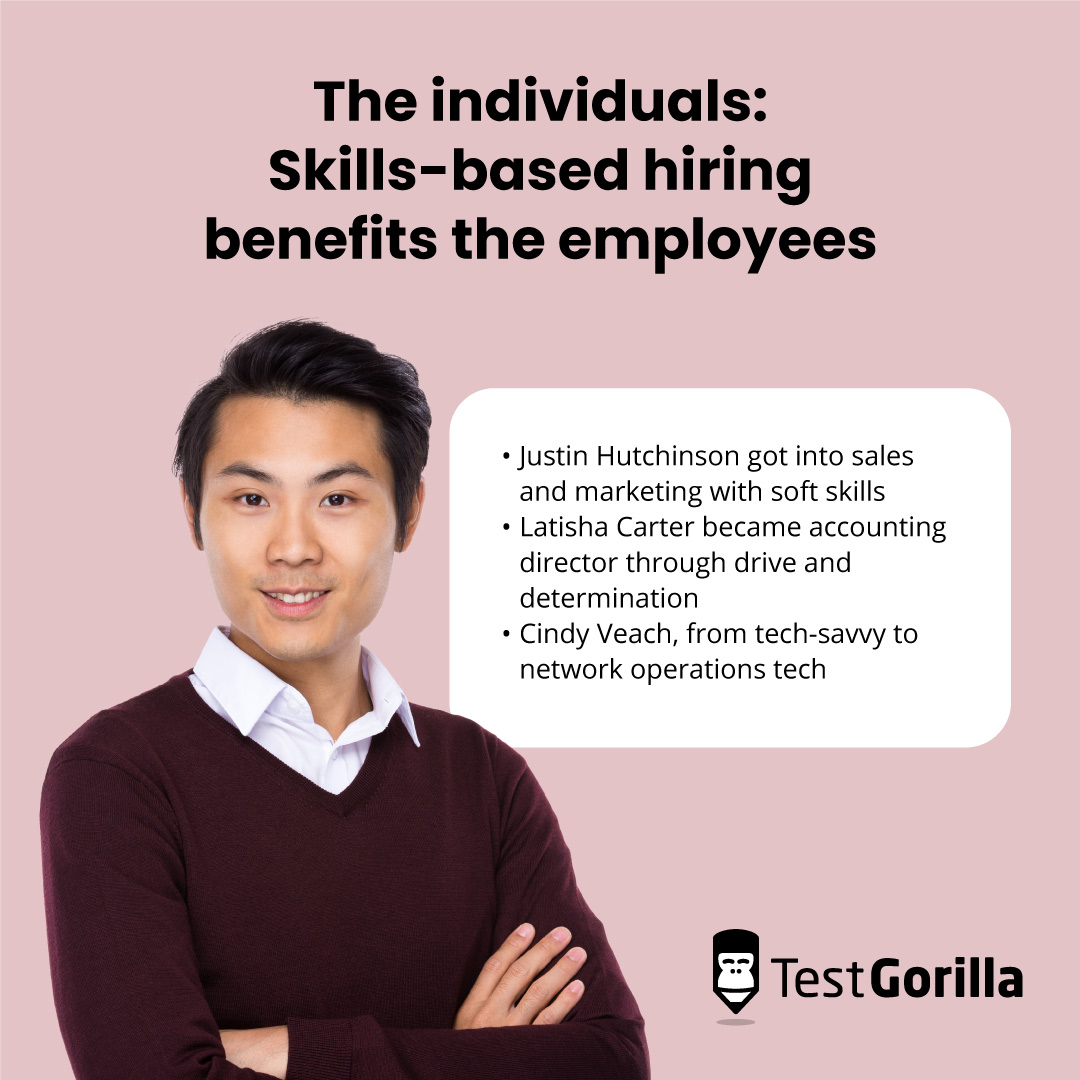
1. Justin Hutchinson
Justin Hutchinson wanted a future in football, but he was faced with a hard choice at age 14: Focus on his career prospects or take care of his father with cancer.
Justin, of course, chose his father and has never regretted that choice, but it did mean giving up the chance of achieving his dream job.
After his father’s passing, Justin attended a community college to fulfill his father’s wish for him to get a degree. To pay rent and living expenses, Justin got a job at a smoothie franchise.
His aim was to simply support his cost of living by making fast food – but it turns out Justin’s real skill was people and communication.
Justin would study the cars that drove up, memorize their orders, and have them ready so he could spend time talking and getting to know the customers instead of making drinks.
One of Justin’s customers was a chief executive of a marketing company and was so impressed with his people skills, he offered Justin an internship.
It wasn’t long before Justin used his soft skills to turn that internship into a full-time position. He dropped out of college, poured his heart and soul into the role, and attained the role of Director of Business Development.
Justin attributes his success to his best skills:
Workplace empathy
Strategic and critical thinking
Sales management
Justin didn’t have a typical marketing background – his experience was a partial college education with no degree, on-the-job experience (and not a traditionally “relevant” job), and his internship.
Not everyone can find the perfect marketer in a charismatic smoothie server, but online skills testing holds the same principles: Look at abilities first and ask questions later.
Sales and marketing are industries that are uniquely dependent on soft skills, which makes skills-based hiring an obvious choice for recruiting. For information on how it helps with the tricky subject of ramp time, read our article on skills-based hiring and ramp time.
2. Latisha Carter
Latisha Carter had a dream of excelling in corporate America, but she never got the opportunity to attend college.
At age 17, Latisha became a single mother. This put her dreams of college on hiatus for the foreseeable future.
Three years later, after having another child, Latisha got a job as a nursing assistant. But she still couldn’t shake her desire to make it in the corporate world.
She secured a call center job with NCR, a software company, driven by their offer of extensive employee training.
Offering extensive upskilling and reskilling is one of the best things you can put on the table for potential candidates. A study by Lorman showed that 59% of Millennials believe that development opportunities are extremely important when deciding whether to apply for a position.
Latisha used her experience at NCR to get a role in customer service at the software company Sage.
With determination and hard work, she continued to work her way up for 20 years until she became a director at Xero, an accounting technology company.
Latisha is now proudly a director in corporate America with no college degree. Her company is reaping the benefits of her presence and skills.
In the second half of 2021, Xero’s approach to skills-based hiring and its emphasis on diversity pushed a 7% increase in racial and ethnic diversity.
Jana Galbraith, the executive general manager for people experience partnering for Xero, says: “ [H]istorically, hiring based on degree exclusively has perpetuated discrimination .”
This boost is great news for Xero because the benefits of diversity are broad and include increased productivity, innovation, and financial performance.
Latisha’s struggle to succeed is unfortunately common for working mothers. To learn more about this, read our article on the motherhood penalty .
3. Cindy Veach
Cindy Veach didn’t have a traditional background. She had all the tech know-how, but she only had experience involving massage therapy and social services.
But she had the skills and she knew it. Cindy says it was a happenstance that she stumbled upon her perfect role; she just wanted a role where she could use her best talents.
“I was looking for jobs I had the right skills for, organizational skills in particular,” said Cindy.
She happened upon a tech administration apprenticeship program at IBM. Before then, she saw her tech skills as just a hobby and never imagined herself in the tech industry – but she applied and was accepted.
Cindy had a steep learning curve ahead of her. She possessed the base tech skills but needed the training to reach the right level.
She attributes much of her success to the flexibility of her mentors. They continually told her that if a path “didn’t feel right,” she was welcome to experiment and try something new.
At the end of the apprenticeship, she applied for a network operations technician role and was hired. She took a position with flexible work options so she could still care for her two children comfortably.
Skills-based hiring made this outcome possible. Cindy’s communication skills, digital expertise, and problem-solving abilities helped her secure her role, and the focus on continuous improvement is helping her develop it .
She says that the combination of her appetite for learning and her employer’s support for her success is the perfect duo for creating limitless growth.
We’ve heard plenty of people say “skills-based hiring doesn’t work in my industry.” But that’s just yet another myth we’ve debunked . Let’s take a look at a handful of case studies about how companies within certain industries have succeeded with skills-based recruitment initiatives.
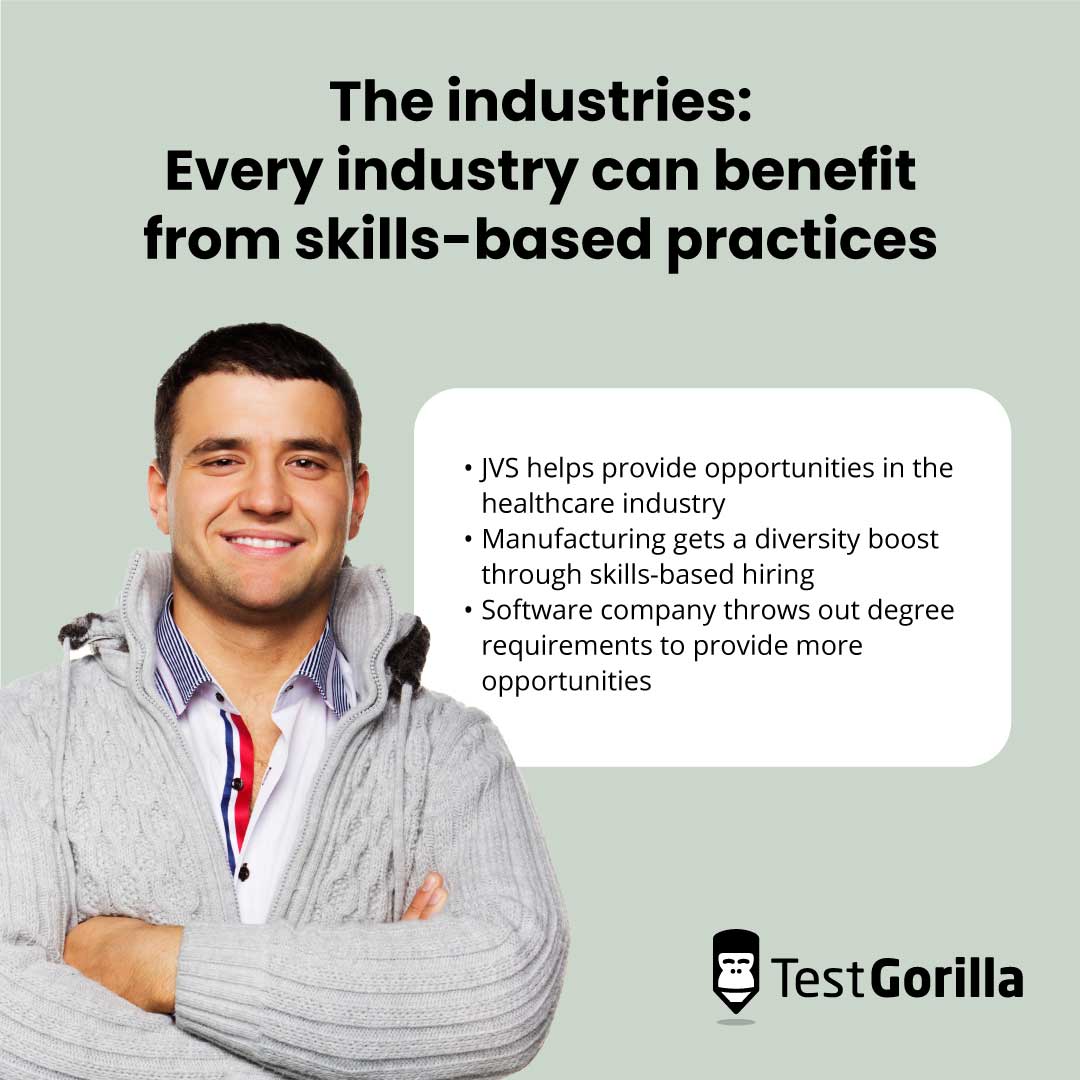
4. Healthcare
Healthcare administration is an industry that’s notoriously difficult to get into. Between receiving a bachelor’s degree and completing a master’s program, it can take six to eight years of rigorous commitment.
However, more opportunities are arising that allow equally qualified candidates to get in without obtaining specific educational requirements.
Sam Saucedo-Hernandez had a tumultuous life, but she only ever wanted a solid career. As a child of parents who emigrated from Mexico, she wanted to be the first generation in her family to attain a degree.
Sam watched her parents struggle with low-wage jobs and promised herself she would do better for herself.
Her first attempt was at law school where she spent several years studying hard. Sam was ecstatic to get her degree and begin a career in law.
But two weeks after she got her associate of science degree, the school got shut down for fraud, leaving Sam jobless and $60,000 in debt.
Sam faced many challenges, but the turning point in her story was the day she received a letter promoting a no-cost medical administrative assistant job training program from JVS.
JVS is a program that helps people build skills and find solid career connections – particularly in the healthcare industry.[1]
JVS has seen amazing success with over 500 employer partners and an emphasis on promoting diversity: 88% of their participants are Black, Hispanic, Asian, or a wide range of other ethnicities.
Sam applied for the program and was accepted. She secured a position as a medical administrative assistant, but her training has led her to her current role in the audiology department.
Though she’s fortunate for her position, Sam says she’s still looking forward, wondering where her skills can take her from here.
Programs like JVS are working tirelessly to make more stories like this possible. With a focus on skills over experience, they bring in valuable candidates to industries that may otherwise be restricted to them.
5. Manufacturing
Steelcase, a furniture manufacturing company, wanted to build a fairer place for employment opportunities and encourage better representation for employees of color. So they adopted skills-based hiring practices.
They’re far from the only ones. According to TestGorilla’s State of Skills-Based Hiring report, 85% of businesses in 2023 had the goal to increase diversity.
And companies are succeeding at this by implementing skills-based hiring: 91% of organizations saw an increase in diversity due to skills-based hiring.
Steelcase realized that if they truly wanted to boost their DE&I initiatives , traditional hiring methods wouldn’t do.
They decided their hiring processes needed to be revamped for the better, so they adopted some new practices:
Prioritizing skills over resume and pedigree
Removing experience requirements wherever possible
Favoring continuous improvement over perfection
Revamping job descriptions to reduce biased language
Prioritizing diversity among equally qualified candidates
Steelcase decided that practices like these would enable them to reach diverse talent organically, and it worked. Since the program started, Steelcase’s new hires are 55% women and 30% racial or ethnic minorities.
Steelcase’s initiatives are amazing, so we encourage similar active moves to boost diversity. To read more about this topic, read our blog on why being intentional about workplace diversity is non-negotiable .
6. Software
ADP, an HR management software company, adopted a recruiting strategy to focus on skills , rely less on credentials, and make an effort to provide opportunities for candidates with nontraditional backgrounds.
This strategy included training talent acquisition professionals on best practices, hiring specific diversity recruiters, removing degree requirements from high-volume recruiting roles, and leveraging better training and mentorship for new hires.
What were the results? ADP saw great success in one year:
An increase in the number of candidates with no college degree
An increase in Black representation in the candidate pool
An increase in Hispanic representation in the candidate pool
This program was heavily inspired and backed by Maria Black, the chief executive of ADP, and her strong belief in corporate social responsibility.
She has a strong passion for supporting working women, veterans, and other underrepresented talents.[2]
Maria is an excellent example of the power of leading from the top. When your company’s leadership supports a great cause, it benefits both employees and company alike and builds a better organizational culture .
Next, let’s take a look at some case studies about the regions and countries that are taking on skills-based recruitment practices. For more on this subject, check out our post on skills-based hiring around the world .
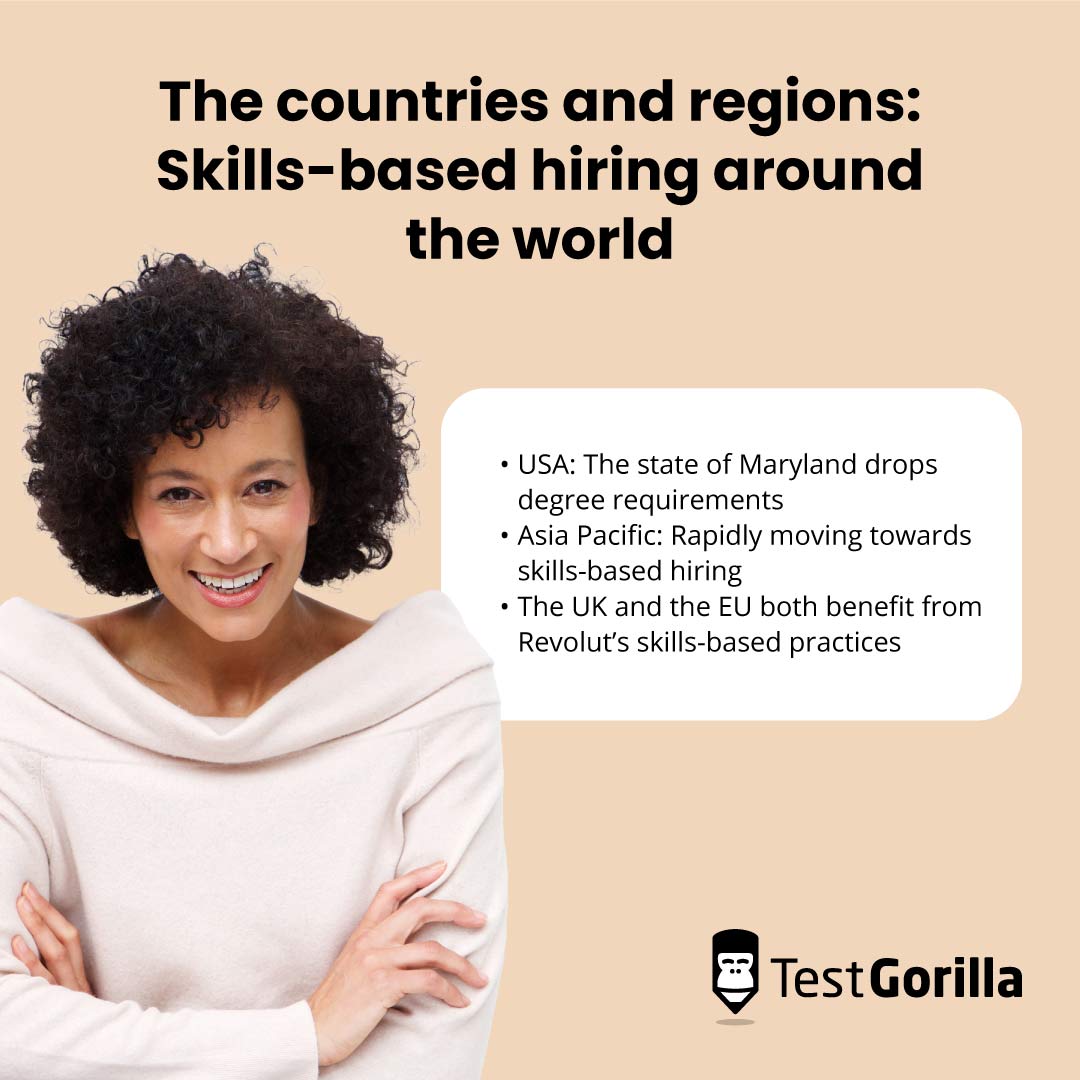
7. Maryland, USA
In 2022, the state of Maryland dropped four-year degree requirements for thousands of jobs in the government sector.
The aim of this initiative was to draw attention to the value of alternative credentials and experience. State officials want to give people a better shot at securing a stable, fulfilling job.
Governor Larry Hogan was quoted as saying:
“[W]e are ensuring qualified, non-degree candidates are regularly being considered for these career-changing opportunities.”[3]
Over 38,000 people work for the state of Maryland and it’s estimated that more than half of those jobs can be performed by people whose alternative skill routes can easily substitute for a college education.
These alternative routes include:
Life experience
Non-relevant job experience
Hobbies and volunteer work
Alternative training
Community college education
Maryland estimates that about 47% of its working population are STARs (skilled through alternative routes). That’s 2.8 million workers, and these people need solid opportunities – opportunities that they can access through skills-based hiring.
To learn more about how unnecessary degree requirements are holding top talent back, read our blog on degree inflation .
8. Indiana, USA
Indiana’s tech leaders are struggling to attract and retain great talent. They’re facing a major skill shortage and they can’t solve it with the “usual” hiring methods.
Traditional recruiting methods exclude over 95% of Indiana’s workforce.
Indiana has a workforce of 3,332,239 people, but consider this:
A four-year degree requirement removes 75%
Biases can eliminate up to 30% of the pool
Requiring specific past experience removes 93% of the talent pool
With all of that in mind, a pool of more than three million candidates is reduced to just over 42,000.
Indiana’s Office of Technology (IOT) realized that skills-based hiring practices could fix this problem and solve their shortage.
They started by removing degree requirements from most job descriptions, then took the next step and started offering reskilling opportunities to workers from alternative industries, such as line cooks and truck drivers.
Tracy Barnes, IOT’s chief information officer, said that the results of the program have been positive and they’re “very pleased” so far. She also said that she’s equally excited to see the positive life impacts for the candidates involved.
9. Asia-Pacific
Skills-based hiring is quickly gaining traction in the Asia-Pacific area.
One study showed that 79% of businesses in the Asia-Pacific area look for skills when hiring versus the 21% that prioritize education and experience.[4]
The same study found that internal mobility is more important than ever and that companies want to prioritize gender equality and disability inclusion . These points can also be accomplished by adopting skills-based hiring.
Asia-Pacific is looking to skills-based practices to improve the future of their recruitment processes, but Singapore-based TruTrip is already reaping the benefits .
TruTrip is a business travel management company that needed help assessing candidate skills and hiring the best candidates, so they gave TestGorilla a try.
Here are a few ways that TestGorilla’s pre-employment skills testing helped TruTrip’s recruitment processes:
Gives them a way to objectively assess applicants’ skills and knowledge
Helps them eliminate bias from the hiring process
Enables them to consistently make better hiring decisions
Reduces their reliance on resume screening
Enhances teamwork and communication
Improves the employee experience of new hires
According to Hugh Batley, the founder of TruTrip, their new hires are a better fit. These employees become great contributors and have a better initial experience with the company.
TestGorilla also helps TruTrip save thousands of dollars by reducing the chances of a costly mis-hire.
This isn’t unusual. According to TestGorilla’s State of Skills-Based Hiring report, 92.5% of organizations using skills-based practices saw a reduction in mis-hires in 2022.
10. The UK and the EU
The UK and the EU have developed a strong focus on skills over the past few years.
Interest in skills-based hiring in the UK rose 63% from 2021 to 2022 . This drastic increase is due to employers wanting a wider talent pool and candidates prioritizing and valuing their alternative experience.
This move is helping job opportunities reach the 73.6% of people in the United Kingdom who don’t possess a four-year degree. [5]
As for the European Union, they developed the “Pact For Skills” program in 2020. This program was created to encourage and fund better upskilling and reskilling while also promoting greater diversity and gender equality.[6]
A good example from both areas is the British-Lithuanian bank, Revolut.
Revolut adopted skills-based hiring by using TestGorilla’s skills tests and, as a result, improved their time-to-hire by 40% .
Among many other benefits, Revolut found TestGorilla’s language tests life-saving. Assessing language proficiency is essential for a multinational company, but traditional methods are time-consuming and laborious.
TestGorilla’s language tests help Revolut to quickly and easily evaluate their candidates’ reading, writing, listening, and speaking skills. This helped them to nearly fully automate their screening process, improving time-to-hire greatly.
To read more case studies and success stories about skills-based hiring, check out our 10 stories that demonstrate the power of skills-based hiring or our collection of customer case studies .
Here are 3 top picks from our case studies:
Revolut improves time-to-hire by 40% using TestGorilla
Design Pickle uses TestGorilla to boost application completion rate by 25%
TestGorilla helps TruTrip to save money and improve employee experience
If you’d like to acquaint yourself with a solid skills-based hiring practice, browse our test library and review our skills tests.
“JVS 2022 Impact Report”. (2022). JVS . Retrieved March 6, 2023. https://impact2022.jvs.org/
“Maria Black, president and CEO”. (n.d). Business Roundtable. Retrieved March 6, 2023. https://www.businessroundtable.org/about-us/members/maria-black-president-and-ceo-adp
McGraw, Mark. (April 4, 2022). “Dropping Degree Requirements: Do Employers Still Care About Education?”. World at Work . Retrieved March 6, 2023. https://worldatwork.org/resources/publications/workspan-daily/dropping-degree-requirements-do-employers-still-care-about-education
“The Future of Talent”. (2021). LinkedIn . Retrieved March 6, 2023. https://business.linkedin.com/content/dam/me/business/en-us/talent-solutions/resources/pdfs/future-of-talent-whitepaper.pdf
“Overview of the education system”. (2022). Education GPS . Retrieved March 6, 2023. https://gpseducation.oecd.org/CountryProfile?primaryCountry=GBR&treshold=10&topic=EO
“Pact for Skills”. (November 10, 2020). European Commission . Retrieved March 6, 2023. https://ec.europa.eu/social/main.jsp?catId=1517&langId=en
Related posts
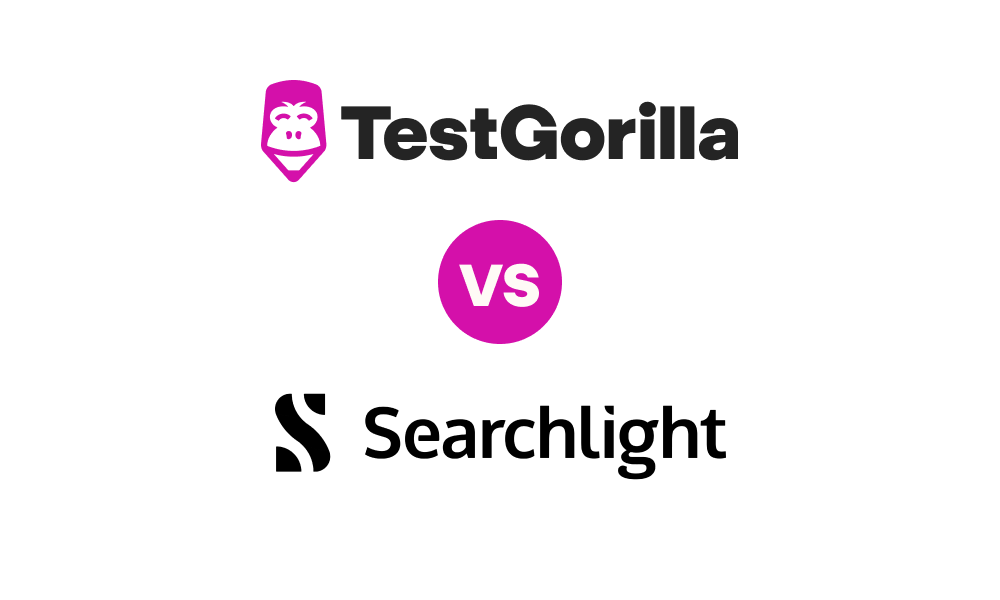
TestGorilla vs. Searchlight.ai

Skills assessments help software engineer Nikolay prove his talent to international employers

From politics to customer success: Skills assessment reshaped Silvia's career
Hire the best candidates with TestGorilla
Create pre-employment assessments in minutes to screen candidates, save time, and hire the best talent.

Latest posts

The best advice in pre-employment testing, in your inbox.
No spam. Unsubscribe at any time.
Hire the best. No bias. No stress.
Our screening tests identify the best candidates and make your hiring decisions faster, easier, and bias-free.
Free resources

This checklist covers key features you should look for when choosing a skills testing platform

This resource will help you develop an onboarding checklist for new hires.

How to assess your candidates' attention to detail.

Learn how to get human resources certified through HRCI or SHRM.

Learn how you can improve the level of talent at your company.

Learn how CapitalT reduced hiring bias with online skills assessments.

Learn how to make the resume process more efficient and more effective.

Improve your hiring strategy with these 7 critical recruitment metrics.

Learn how Sukhi decreased time spent reviewing resumes by 83%!

Hire more efficiently with these hacks that 99% of recruiters aren't using.

Make a business case for diversity and inclusion initiatives with this data.

- Request A Demo Start free trial --> Login
Recruitment Cost Analysis: Maximizing Talent Acquisition
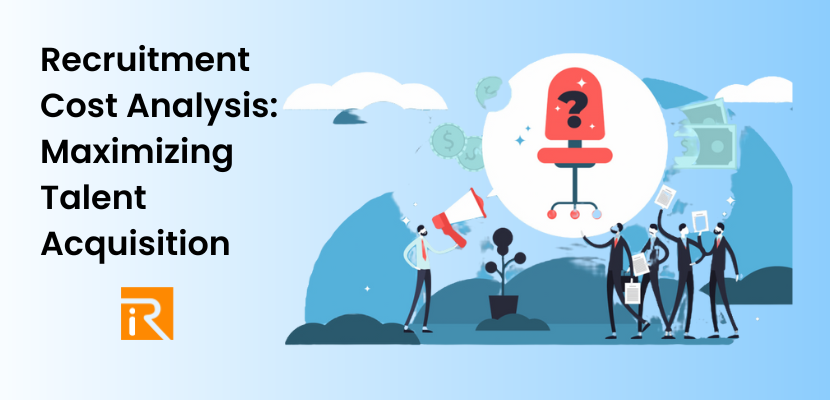
Factors Impacting Recruitment Costs
Calculating recruitment costs, benefits of recruitment cost analysis, tools and software for cost analysis, best practices for effective cost analysis, case study: real-life cost analysis example.
Recruitment Cost Analysis is a critical practice that helps organizations optimize their hiring processes while keeping expenditures in check. We know that recruitment efforts account for 15% of Human Resources expenses.
In this blog, we will delve into the intricacies of Recruitment Cost Analysis, its importance, and how it can be a game-changer for your HR strategies.
Advertising and Marketing
Effective job postings and recruitment campaigns play a significant role in attracting qualified candidates. Here, we’ll discuss the strategies to optimize your advertising and marketing expenses while maximizing reach.
Screening and Assessment Tools
The tools used for evaluating candidates can either streamline the selection process or become a financial burden. We’ll explore cost-effective assessment solutions and their impact on recruitment costs.
Recruitment Agencies
Many organizations collaborate with recruitment agencies. We’ll analyze the cost-effectiveness of this approach and provide insights into selecting the right agency.
Onboarding and Training
Onboarding and training processes are often overlooked when calculating recruitment costs. Discover how investing in these areas can reduce long-term expenses.
Direct Costs
These are the obvious expenses, such as job posting fees and background checks. Learn how to itemize and calculate these costs accurately.
Indirect Costs
Indirect costs, such as employee time spent on interviews, also affect recruitment expenses. We’ll discuss methods for quantifying these less obvious expenditures.
Hidden Costs
Hidden costs, like reduced productivity during the transition period, can be significant. Understand how to uncover and incorporate these into your analysis.
Cost-Per-Hire Formula
We’ll introduce the cost-per-hire formula and explain how it can provide valuable insights into your hiring processes.
Identifying Cost-Efficient Channels
Discover which recruitment channels deliver the best value for your investment.
Improving Recruitment Strategies
Leverage data from your cost analysis to refine your hiring strategies.
Maximizing ROI
Learn how optimizing recruitment costs can lead to a higher return on investment in your workforce.
Reducing Turnover
Uncover how reducing recruitment costs can also reduce employee turnover, saving your organization money in the long run.
Applicant Tracking Systems
Explore the benefits of ATS systems and how they can simplify cost tracking.
Cost Analysis Software
Discover specialized software designed to streamline the recruitment cost analysis process.
Excel Templates
For those on a budget, we’ll provide downloadable Excel templates to kickstart your cost analysis.
Data Collection and Documentation
Properly collecting and documenting recruitment data is key. We’ll guide you through the process.
Periodic Analysis
Learn why conducting regular cost analyses is essential for ongoing improvement.
Benchmarking
Benchmark your recruitment costs against industry standards to gauge your organization’s efficiency.
Scenario Overview
We’ll present a real-world case study, showcasing how a company successfully implemented Recruitment Cost Analysis.
Cost Analysis Process
Step by step, we’ll detail how the company conducted its analysis and the outcomes it achieved.
Outcomes and Learnings
Discover the tangible benefits and lessons learned from this case study.
In conclusion, Recruitmen t Cost Analysis is a powerful tool for optimizing your talent acquisition processes.
By understanding and strategically managing your recruitment costs, you can attract top talent while keeping your budget in check.
Start your journey towards a more cost-effective and efficient hiring process today.

- 6216 Baker Road Suite 120 Eden Prairie, MN 55346
- +1(952) 548-6629
- [email protected]
- [email protected]
- Recruitment & ATS
- Sales & CRM
- Onboarding and e-signatures
- Marketing and Campaigns
- Sourcing and Job Boards
- Back office
- Reporting and Analytics
- ATS/CRM Comparison
- Smart Recruiters
- Integrations
- Migrate & Save Upto 70%
- Data Migration
- Refer and Earn
- Applicant Tracking System
- GDPR Compliance
- Start Free Trial

Available Tools:
- Resource Library Arrow with stem
- Benchmarks on Demand Arrow with stem
- Certification Arrow with stem
- Training - Self Paced and In Person Arrow with stem
- Research Agenda Arrow with stem
- Peer to Peer Arrow with stem
- Blog Arrow with stem
Check out our most frequently asked questions or feel free to contact us online or call us at 1-800-776-9676 or +1-713-681-4020
- Benchmark Your Recruiting Practice
HR benchmarking metrics are growing in popularity, but they’re typically expensive and difficult to get. You can gain a lot of insight from this information though. Benchmarking helps organizations understand where they stand compared to others in their industry. This information can allow them to improve, develop, and make key decisions. For example, benchmarking metrics can show areas of weakness; using this insight, businesses can figure out what to do to progress.
Kris Dunn of the HR Capitalist and Fistful of Talent mentioned a free and exciting option to get a recruiting benchmarking report from APQC on his blog . To take advantage of this opportunity, click here to take the survey. You’ll need some key information about your recruiting function such as costs and cycle time.
In exchange for your participation, you’ll receive a free benchmarking report filled with information to leverage better performance from your recruiting function.
Want to see other benchmarking surveys? Comment below or tweet me .
Salary Benchmarking and beyond
According to a recent survey, over a quarter of workers plan to move roles in the next 6 months. With the average cost of employee turnover sitting at over £30,000, benchmarking can help your organisation improve retention and minimise employee turnover costs.
Retention. Retention. Retention.
What is benchmarking, how to conduct a benchmarking study.
- Salary benchmarking
Rewards and benefits benchmarking
Diversity benchmarking.
Learning and development
How benchmarking affects your business
Turning data into tangible goals, how can you ensure that your employees aren't just happy but also want to stay and grow with your organisation.
We’re big believers in a holistic approach to talent management. If you can’t retain staff, no amount of acquisition will ensure long-term success.
While employees are swaying towards stability amid economic uncertainty, the number of employees planning to move roles remains historically high. Meanwhile, increased demands for transparency from candidates and through regulatory measures are making it ever more critical that businesses assess the competitiveness of their offer.
A 2023 Randstad survey found that 26% of employees plan to switch jobs in the next 6 months, down from 41% in 2022 during the peak of what was dubbed ‘The Great Resignation’. The 2023 Retention Report by the Work Institute provides a view of the US economy and reports over fifty million voluntary departures in 2022. In context, this meant a third of the US workforce changed jobs in that year. Around 15% of workers still fear losing their jobs, a number which is consistent year on year, suggesting the factors influencing switching roles lie elsewhere.

The two biggest attraction factors continue to be work-life balance and remuneration, with career progression in third. It’s no surprise that the youngest demographic is most open to changing their role, with those later in their career more likely to prefer stability.
Research by Oxford Economics and Unum shows that the average cost of employee turnover is £30,614, which can substantially increase if you hire and train for a specialist role in your organisation. This means if you were to lose four employees in a year, it would ultimately cost the business over £120,000 to replace lost staff and bring those new to the role up to speed.
So, what can you do to combat this? How can you attract and retain employees who want to stay and grow with your organisation? With 35% of staff leaving organisations within their first year, a retention strategy is vital.

There are several ways to approach this, including by ensuring you have a robust wellness programme and are ahead of the curve when it comes to Diversity and inclusion . However, to make a real impact on attrition rates, you must confront the most significant factors in voluntary attrition: remuneration and career advancement .
At the heart of this is a competitive compensation package, which includes competitive rewards and benefits and a clear programme for learning and development.
So, how do you ensure what you offer is competitive? The truth is that it’s impossible to judge without looking at what similar businesses are doing, and this is no easy task. With salaries being well-kept secrets on job advertisements and competitors being tight-lipped about their offerings, it can be hard to understand where you’re going right or wrong as a business.

- AI & Talent Acquisition
- Cost of recruitment
- Employee Experience
- The Future of Talent Acquisition
- Scramble for AI Talent
- All Services
- Talent Intelligence
- Talent Search
- Talent Mapping
- Talent Pipelining
- Location planning
- Case Studies
- Testimonials
- Giving Back

Why should you benchmark?
“You may want to ensure you’re remaining a top employer, an employer of choice, or you may want competitor analysis to know what your competitors are doing.”
Keisha Johnson, Recruitment Manager at Weil, Gotshal & Manges LLP
Benchmarking is a solution that provides the real-time data and insights you need to understand how your offer compares in the market. It highlights areas where you excel alongside those that need improvement.
Benchmarking principles can be applied to various areas, including:
- Learning and development benchmarking
Download the guide
Want to read this offline or share with a colleague? Simply fill in some details to download a copy.
Step 1: Create a focused brief
For salary benchmarking, this means deciding which role or title to focus the research. A wider piece of work could address salary bands in a specific area. For other benchmarking studies, this may include defining the competitor organisations.
Step 2: Assess the internal offer
Map your internal offer, including seniority and responsibilities, titles, salary, and benefits. This may include mapping role families. For diversity and L&D benchmarking, this involves assessing your existing initiatives.
Step 3: Conduct secondary research
Examine job advertisements and industry news and conduct research through third-party data platforms to assess the offer for similar positions on the market.
Step 4: Conduct primary research
Identify relevant post holders within target organisations and make contact with them to gain first-hand insight into their experience. This enables you to compare the seniority and responsibilities of similar job titles to allow a deeper understanding of remuneration. A third party, like ourselves, enables you to do this in complete confidence.
Step 5: Collate your findings
Consider the location and management responsibilities of similar positions when making salary recommendations.

Independent benchmarking
We help businesses understand how their offer compares, both in terms of salary and total reward.
The most common type of benchmarking concerns salaries. Salary benchmarking uses primary and secondary data sources to accurately benchmark salaries of specific roles within an industry.
Data is collected through job advertisements, third-party labour market data platforms and, most importantly, conversations with relevant post-holders in competitor organisations.
Salary benchmarking is helpful at all levels of an organisation, from junior staff to C-suite leaders.
Whether providing spot salaries or helping to define or update salary bands and pay grades, our salary benchmarking solution provides tailored results that ensure your company stays competitive.
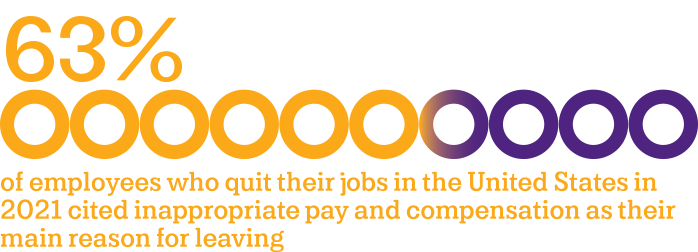
Rewards and benefits benchmarking often go hand in hand with salary benchmarking.
Where salary benchmarking looks at base compensation, a rewards and benefits benchmark determines the total package, providing a better indication of where your offer sits in the market.
This type of benchmarking looks at a broad range of elements, including:
- Bonus structure
- Annual leave
- Parental leave
- Private insurance
- Life insurance
- Car allowances
When taking this broader perspective, you may find that your base salary is higher than the competition, but the overall package falls behind the added value these rewards can offer. Conversely, some employers find they have a comprehensive benefits package, but a stronger salary offer tempts employees away.
Here again, data is derived from real-time conversations with post holders in the industry and other primary data sources such as annual reports and job adverts.
Benchmarking can also be applied to diversity. This approach is gaining popularity as companies seek to increase transparency, track the progress of their diversity programmes, and find ways to improve.
Whether related to gender, sexuality, or cultural background, it is a great tool to help inform strategic decision-making at the executive level.
Diversity benchmarking can influence workforce planning, recruitment practices, and overall corporate strategy to widen the talent pool and ensure fairness throughout the recruitment process.
By understanding where diversity may be lacking, plans and tools can be tailored to your needs and allow your company to develop plans aimed directly at tackling these issues.
We gather insight into diversity in a similar way to salary benchmarking. We speak with appropriate candidates in comparative organisations, map the talent pool, perform data analysis, and determine through additional secondary data sources where industries may need to catch up on affirmative action and diversity planning.

L&D Benchmarking
Recent research by LinkedIn found a clear link between a lack of learning and development opportunities and attrition. Put simply, employees who can’t see a route to advance or learn new skills are more likely to leave.
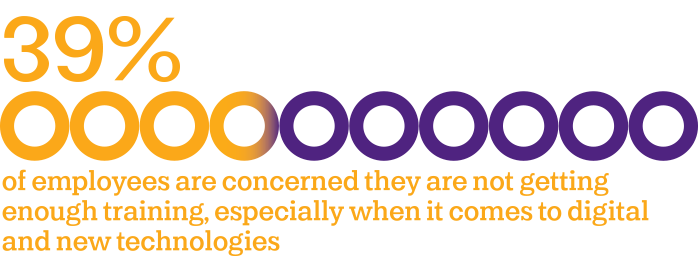
A robust Learning and Development programme helps guard against this exodus whilst providing numerous benefits beyond loyalty. These programmes can help train new skills, update current skills and identify succession paths for star employees.
An L&D benchmark uses a combination of primary and secondary research methods to examine your competition and reveal the programs they offer. This may include relevant technology partners, company initiatives, partnerships, and certifications.

“When we do analysis, we’re looking at the top 25 to 50 roles that drive disproportionate value. We break down the value agenda and ask, “How are we going to make money in the future?” Some parts will be new. Others will be sustaining.”
Bryan Hancock, McKinsey leader and talent expert
Benchmarking enables you and your company to make impactful decisions regarding compensation and reward and can also help you identify how you perform in relation to diversity and learning and development initiatives. This insight is then available to drive change, enabling your business to make informed decisions that affect the whole talent management cycle.
Suppose the benchmarking reveals your company is not offering competitive salaries and benefits. In that case, you have identified a significant factor in recruitment and retention difficulties, especially in niche industries where talent can be hard to find.
On the importance of benchmarking, Keisha Johnson states , “You know what you pay your employees, but if you’re getting pushback, saying that salaries are behind the market, that’s only anecdotal. Salary benchmarking can confirm and allow you to make a business case to allow salaries to be raised or addressed. If you believe something is incorrect, you need evidence to support that.”
"You may have a feeling about what your competitors are paying or what initiatives they offer. Still, by using a benchmarking service like the one available with Talent Insight Group, you get accurate and real-time data, evidenced through primary research and conversation with post holders and secondary data analysis gathered from online analytics tools and job adverts."
Rob Dolan, Senior Research Director , said, “[benchmarking] is beneficial and allows companies to position themselves competitively within their area. If they’re having difficulty in hiring, benchmarking can provide an edge and help determine why they aren’t able to hire.”

How benchmarking helps
As part of significant plans to grow the business across the African continent, our client needed to understand the market, pay and reward data and the competitors operating in that space. We were asked to carry out research and share insights that would help to set the strategy for this essential area of development.
We uncovered the insights they needed, quickly but accurately to minimise risk.
Through benchmarked information, companies are enabling their own future success and growth. With evidenced and insightful information, businesses are in control of their external opinions and narrative within their industry.
Benchmarking can also assist with internal engagement and employee productivity. But how can we use this data and turn it into real results?
Keisha Johnson provides some insight: “For us, when we’ve looked at diversity benchmarking for example, it’s cut and sliced to say ‘yes, you may be behind or ahead of the market’ and you can introduce measures as a business on how to tackle that issue. You can say at X time where were here, and by X date we want to be there .”
You can benchmark at a later date and see the progression that has happened, or where more resource may be required.
She added “if you see there aren’t many women, is that because of the individual business or the sector? Unless you use benchmarking, you don’t know.”
Benchmarking can be utilised to help create progressive salary bands, or compare your total rewards package against your competitors.
If you are offering the same base pay, and your competitor offers a better pension or more attractive benefits, unless you’ve received benchmarking information, you may not be aware of that gap and how that could be impacting your ability to recruit for similar roles.
As employees become more productive, salaries are not reflecting this. According to the Office for National Statistics, employee output is increasing 0.5% quarter on quarter, even with Covid-19 and furloughed workers.
Total hours worked also increased 2.5% quarter on quarter as restrictions unwind and we return to more normal economic activity.
This can increase the risk of employee retention, particularly if your employees are being offered higher salaries or better benefits elsewhere. We also see echoed throughout our research that remote and flexible working are becoming increasingly popular, and are strong motivators for workers looking for a change.
Download a copy
We hope you are finding this guide useful. To download a copy, simply add your details to the form.
How we help
Our talent intelligence service provides various benchmarking services , giving our clients research and insight that helps shape future hiring strategies. Whether you need benchmarks to guide specific role remuneration or company-wide initiatives, we can help.
We can uncover a wealth of information, including:
- Competitor insights, such as organisation design, benchmarking and hiring activity.
- Candidate motivations, understanding whether your offering meets their needs, values and preferences.
- Employer brand perception externally
- Labour market, employment statistics and salary insights
- Location insights to guide decisions about relocations, new offices or facilities or switching to remote or hybrid working models.
- Best practice as an employer, helping you understand the strategies of other businesses, competitors or market leaders.
We work in partnership with our clients to ensure that we uncover the insights you need, and our extensive experience means we can also guide you on the key metrics that will maximise impact. We use a mix of primary and secondary data to ensure our insights are robust and reliable.
- Giving back
- Talent intelligence
- Talent mapping
- Talent search
- Talent pipelining
- Case studies
Information
- Modern Slavery Policy
© Talent Insight Group 2024
Built by r//evolution
To read this content please select one of the options below:
Please note you do not have access to teaching notes, auditing recruitment and selection using generic benchmarking: a case study.
The TQM Magazine
ISSN : 0954-478X
Article publication date: 1 October 1999
This article provides an account of an audit on the recruitment and selection systems and procedures in place within a printing company based in the West Midlands (England). A human resource audit (HRA) of generic benchmarks was developed from a literature review. The audit subsequently was applied to establish the current position of the company in the areas of recruitment and selection. The empirical investigation process primarily consisted of content analysis of documents and the interviewing of 13 staff within the company. As a result of the audit, the recruitment and selection processes, systems and procedures were identified as ineffective. Consequently, an action plan was developed as part of a quality improvement process and preparation for Investors in People Award. As a result of the implementation of the recommendations, the culture of the company and the staff should become more focused, systematic and of a higher quality.
- Benchmarking
- Printing industry
- Recruitment
Ifill, S. and Moreland, N. (1999), "Auditing recruitment and selection using generic benchmarking: a case study", The TQM Magazine , Vol. 11 No. 5, pp. 333-341. https://doi.org/10.1108/09544789910282435
Copyright © 1999, MCB UP Limited
Related articles
All feedback is valuable.
Please share your general feedback
Report an issue or find answers to frequently asked questions
Contact Customer Support

Case Study: Improving Recruitment Processes – Part 1 of 2
Published: May 26, 2014 by Niraj Goyal

In this case study, a team strives to improve the recruiting process in a large, fast-moving consumer goods company. Part 1 focuses on reducing the recruiting cycle time. Part 2 focuses on decreasing the effort required to fill a job opening .
Rising attrition is a common problem across industries. Tight monthly, quarterly and annual objectives leave little room for error when it comes to having the required manpower being available consistently. Unwanted attrition results in two significant challenges for human resources (HR) teams. They must work to continuously:
- Decrease cycle time to fill a job opening.
- Decrease the effort required for a successful recruitment.
The case described here uses total quality management (TQM) to address these problems in a large, fast-moving consumer goods company in India. ( Note: The details of the process have been condensed and modified for the sake of confidentiality and easy of storytelling .)
A two-day quality awareness program introduced the cross-functional project team members to TQM (including just-in-time [JIT], total quality control [TQC] and total employee involvement [TEI]). Fortnightly meetings then started to address the problem at hand through the seven steps of problem solving:
- Define the problem
- Research the causes
- Generate countermeasure ideas
- Test and modify the ideas
- Implement ideas
- Standardize procedures
- Compile quality improvement story
The case study is described in two parts: 1) decreasing cycle time and 2) decreasing effort.
Step 1: Define the Problem
Following the recommend practice of TQM, the project team began by defining the beginning and end of the process – in this case, the start and finish of the recruitment process . The possible starting and end points are shown in Table 1 below.
| Employee resigns or there is otherwise an available position (1) | Make employment offer to successful candidate (3) |
| HR receives email for initiating recruitment (2) | Employee starts work (4) |
After discussion the group agreed to take up the process between HR’s receiving an email to initiate recruitment (Point 2) and an offer being mailed to a candidate (Point 3). It was concluded that the events between Points 1 and 2 and then between Points 3 and 4 were not within the control of the project team.
To measure the current state ( problem = desired state – current state ) of cycle time data, an overview of past recruitments was pulled.
| Average cycle time (A) | 64 days |
| Standard deviation (σ) | 52 days |
| A + 3σ | 219 days |
The team members agreed (after heated discussion) that they would be happy with the result if they could reduce the current state of A + 3σ of 219 days to 45 days – an aggressive 80 percent reduction target.
Steps 2 and 3: Research the Causes/Generate Countermeasure Ideas
In JIT problems, the process of improvement typically involves the following three steps:
- Draw current state process map .
- Apply JIT principles to generate countermeasure ideas.
- Draw proposed process map including both value added and non-value added (NVA) activities.
The current process steps from HR’s receipt of the initial request to fill a position through to the offer letter being accepted are shown in Table 2.
| 1 | Send resignation message to HR with request to initiate recruitment |
| 2 | HR manager directs hiring team to start the recruitment process |
| 3 | Log into employment website/contact recruiter |
| 4 | Identify/collect candidate resumes |
| 5 | Receive resumes |
| 6 | Shortlist resumes |
| 7 | Send shortlisted resumes to department manager |
| 8 | Agree to interview date |
| 9 | Call candidate for interview |
| 10 | Interview 1 |
| 11 | Interviewers complete feedback form |
| 12 | Send feedback form to HR |
| 13 | Plan for interview 2 |
| 14 | Schedule interview 2 |
| 15 | Interview 2 |
| 16 | Interviewers complete feedback form |
| 17 | Send feedback form to HR |
| 18 | Identify/collect resumes (batch 2) |
| 19 | Receive resumes |
| 20 | Shortlist resumes |
| 21 | Identify/collect resumes (batch 3) |
| 22 | Receive resumes |
| 23 | Shortlist resumes |
| 24 | Interview 3 |
| 25 | Interviewers complete feedback form |
| 26 | Send feedback form to HR |
| 27 | Select candidate |
| 28 | Email HR regarding selected candidate |
| 29 | Send offer letter |
The key JIT countermeasure ideas to reduce cycle time are to:
- Reduce waiting time (typically 50 percent to 70 percent of cycle time) between finish of one activity and start of the next activity, and
- Eliminate NVA activities – activities that add time to the process but no value.
Step 4: Test and Modify the Ideas
The team first focused on reducing waiting time. In order to quantify the potential of reducing waiting time, a test was proposed: process one job opening with all members of the team being briefed to not let the activity wait at their desks and to record how much time it took to complete the relevant tasks. The results are detailed in Table 3 below.
| 1 | Send resignation message to HR with request to initiate recruitment | 0 |
| 2 | HR manager directs hiring team start the recruitment process | 25 |
| 3 | Log into employment website/contact recruiter | 35 |
| 4 | Identify/collect candidate resumes | 4,320 |
| 5 | Receive resumes | 1,080 |
| 6 | Shortlist resumes | 120 |
| 7 | Send shortlisted resumes to department manager | 5,760 |
| 8 | Agree to interview date | 8,890 |
| 9 | Call candidate for interview | 30 |
| 10 | Interview 1 | 1,020 |
| 11 | Interviewers complete feedback form | 330 |
| 12 | Send feedback form to HR | 0 |
| 13 | Plan for interview 2 | 40 |
| 14 | Schedule interview 2 | 2,880 |
| 15 | Interview 2 | 5,880 |
| 16 | Interviewers complete feedback form | 120 |
| 17 | Send feedback form to HR | 0 |
| 18 | Identify/collect resumes (batch 2) | 1,440 |
| 19 | Receive resumes | 1,440 |
| 20 | Shortlist resumes | 1,440 |
| 21 | Identify/collect resumes (batch 3) | 8,640 |
| 22 | Receive resumes | 1,440 |
| 23 | Shortlist resumes | 60 |
| 24 | Interview 3 | 2,880 |
| 25 | Interviewers complete feedback form | 0 |
| 26 | Send feedback form to HR | 0 |
| 27 | Select candidate | 0 |
| 28 | Email HR re selected candidate | 0 |
| 29 | Send offer letter | 0 |
The team was greatly enthused with the result of 33 overall process days when compared to the past average of 64 days and A + 3σ of 210 days. The team believed that the targeted reduction of 50 percent was achievable.
Next the team turned to reducing NVA activities and rework. Looking at the activities in the existing process revealed that not finding enough suitable candidates was a recurring problem. The effectiveness and breadth of the initial candidate search was enhanced to avoid rework. This led to the elimination of seven out of the 29 steps in Table 3. The now 22-step process is shown in Table 4.
| 1 | Send resignation message to HR with request to initiate recruitment | 0 | |
| 2 | HR manager directs hiring team to start the recruitment process | 25 | |
| 3 | Log into employment website/contact recruiter | 0 | |
| 4 | Identify/collect candidate resumes | 360 | |
| 5 | Receive resumes | 5 | |
| 6 | Shortlist resumes | 60 | |
| 8 | Send shortlisted resumes to department manager | ||
| 9 | Agree to interview date | 0 | |
| 10 | Call candidate for interview | 30 | |
| 11 | Interview 1 | 300 | 960 |
| 12 | Interviewers complete feedback form | 30 | |
| 13 | Send feedback form to HR | 0 | |
| 14 | Call candidate for interview 2 | 5 | |
| 15 | Confirm interview date | 15 | |
| 16 | Interview 2 | 180 | 960 |
| 17 | Complete feedback form | 10 | |
| 18 | Compensation offer determined | 60 | |
| 19 | Compensation offer sent for approval | 0 | |
| 20 | Approval received | 120 | |
| 21 | Send offer letter | 30 | |
| 22 | Offer accepted | 480 | |
The group was asked to estimate a fair time for each step with no undue delays. The revised process includes some waiting time when it comes to directly interacting with candidates, whose availability is an uncontrolled variable. The total of all times added up to eight working days and a reduction of 75 percent in cycle time. The drop from 33 days (shown in Table 3) to eight days pleasantly surprised the group.
Testing this idea was achieved by treating one recruitment as a special case and ensuring the minimum waiting time through the process. Team members recorded how long each step took to complete.
The test recruitment took 18 days compared to 33 days originally. Two further recruitment test cases took six days each.
Step 5: Implement Ideas
The process was implemented for all future recruitments. The cycle time for each recruitment was plotted in a graph shown below. The reductions in cycle time achieved in 25 recruitments are shown here.
| Average (A) | 63 | 8 | More than 85% |
| A + 3σ | 175 | 30 | More than 80% |
Step 6: Standardize Procedures
The 22-step process shown in Table 4 was documented, and the staff were trained to adhere to the new recruitment process. Regular tracking of each recruitment was introduced to preempt slack from creeping back into the process. In addition, each recruitment’s cycle time was recorded and graphs were produced to monitor the results. Any delays were analyzed for root causes and addressed.
Step 7: Compile Quality Improvement Story
The quality improvement story was prepared and presented to the company’s management team.
About the Author
Niraj Goyal
- DOI: 10.1108/09544789910282435
- Corpus ID: 154613927
Auditing recruitment and selection using generic benchmarking: a case study
- Sharon Ifill , N. Moreland
- Published 1 October 1999
- The Tqm Magazine
11 Citations
Staffing practices in the private sector in sri lanka, recruitment and selection strategies and practices in the private sector commercial banks of bangladesh: evidence from human resource practitioners, harmonization of the human resource audit in the field of international practice, advancing selection in an sme: is best practice methodology applicable, effect of career fulfilment on employee performance in federal civil service commission, abuja-nigeria, investigating the effect of human resource strategic orientation on employee performance in federal civil service commision, abuja-nigeria, the readiness for human resources management benchmarking and its perceived impact on organizational effectiveness in universities in the gaza strip, support what support : an exploratory study of young people's experiences of living with depression during their student years, the process of recruitment and selection in coca-cola india, recruitment techniques by auditing companies, 5 references, how to recruit, costing human resources: the financial impact of behavior in organizations, 100 methods for total quality management, benchmarking: a tool for continuous improvement, handbook of personnel management, related papers.
Showing 1 through 3 of 0 Related Papers
- Book a Speaker
Lorem ipsum dolor sit amet, consectetur adipiscing elit. Vivamus convallis sem tellus, vitae egestas felis vestibule ut.
Error message details.
Reuse Permissions
Request permission to republish or redistribute SHRM content and materials.
The Future of Hiring: The Role of AI in Modern Recruitment Strategies

For an organization’s recruitment team, artificial intelligence tools like resume parsers or chatbots are game changers. Time is currency, and AI is here to help by automating time-consuming tasks such as candidate sourcing and initial screenings. Technology can liberate HR professionals from basic processes, allowing them to focus on strategic, high-value functions.
For those in HR who are looking to effectively integrate AI into their recruitment strategies, here is a primer on what you need to know to get started.
Benefits of AI for Recruitment
AI tools can offer many benefits for your company’s recruitment processes, including:
- Time savings. Using AI saves recruiters time by scanning resumes to find keywords. While sifting through thousands of applications and resumes, an AI resume parser scrapes information needed to evaluate a client. AI can track qualifications and experience that align with a job description.
- Cost effectiveness. AI decreases the time that HR professionals spend scanning through resumes and applications. This helps HR spend more time on onboarding and training for new employees.
- Hiring success rate. With AI tools such as automated chat assistants or resume screenings, you can move multiple candidates quickly through the hiring process by searching for specific data among your candidate pool and updating them on their status automatically. This technique improves hiring success by building trust and transparency with candidates. When a recruiter is open and transparent, a candidate feels respected during the recruitment process and comes away with a favorable lasting impression.
Popular AI-Powered Recruiting Tools
Two types of frequently used AI recruiting tools are resume parsers and chatbots.
Resume parsers scan resumes and cover letters for words or phrases that match job descriptions, allowing information to be sorted.
Chatbots are software applications or web interfaces that automate workflows and are designed to mimic human conversation through text or voice interactions. Different from a chatbot people use on a clothing site or chat with customer service on Apple or a streaming service, Jasper, Mya, and Google Gemini are examples of chatbots that can be used to mimic human behavior during the recruitment process, to filter out information prior to reaching a physical recruiter.
Ethical Considerations When Using AI For Recruitment
AI can be a helpful tool in recruiting, but there are ethical considerations to be aware of, including bias, accuracy, and privacy.
It’s crucial to be careful with AI because the information it examines can be biased . Make sure the data you input for it to use does not discriminate against any protected groups.
It can also lack accuracy or just not be able to interpret something the same way humans do, so it’s necessary to cross-reference the facts that it outputs and correctly analyze resumes or cover letters.
Be sure to scrape personal information including street addresses and phone numbers from applications so that information is not used again in the AI tool.
Examples of Successful AI Implementation in Recruitment
Case studies of successful AI recruitment demonstrate how different organizations are leveraging this new technology to enhance efficiency, improve the candidate experience, and make data-driven, unbiased hiring decisions.
British consumer goods company Unilever uses HireVue’s virtual interviewing tool to pose questions based on an analysis of successful past interns. It analyzes candidates’ tone of voice and facial movements. This analysis correlates these elements with the traits demonstrated by Unilever’s high-performing employees.
Makeup brand L’Oréal has developed an AI-enabled interview tool from Step Stone’s “ Mya” chatbot. Mya engages candidates by asking specific questions taken from an analysis of current successful L’Oréal employees. The system can evaluate responses, sentence structure, and vocabulary from candidates. The process delivers an efficient and insightful candidate evaluation for HR recruiters.
Best Practices for Integrating AI Tools into Your Existing Recruitment Workflow
Integrating AI into the recruitment process can be tricky, so it’s important to have a strategic plan or approach.
Training on AI for an HR team is vital and will keep everyone on the same page and make for a smooth transition into recruiting with AI tools.
It’s also crucial to find the right tools. Start by assessing where your gaps or opportunities to streamline may be and look for solutions that target your specific needs. SHRM offers a comprehensive playbook on AI that you can download to find additional research and resources to master technology that can further your HR career.
For additional guidance, SHRM provides an enterprise solutions site that works on implementing business solutions tailored to your organization’s unique needs. Act now to revolutionize recruitment processes and find the candidates that best suit your business.
Is AI Replacing Human Recruiters?
To address the elephant in the room: AI is not going to replace human recruiters. It will make their jobs easier and allow recruiters to focus on other tasks like planning orientation for employees and minimizing biases that might influence decision-making.
To stay ahead in the ever-changing field of recruitment, it’s key to understand and take notice of the power of AI.
Related Content

Why AI+HI Is Essential to Compliance
HR must always include human intelligence and oversight of AI in decision-making in hiring and firing, a legal expert said at SHRM24. She added that HR can ensure compliance by meeting the strictest AI standards, which will be in Colorado’s upcoming AI law.

A 4-Day Workweek? AI-Fueled Efficiencies Could Make It Happen
The proliferation of artificial intelligence in the workplace, and the ensuing expected increase in productivity and efficiency, could help usher in the four-day workweek, some experts predict.
Advertisement

Artificial Intelligence in the Workplace
An organization run by AI is not a futuristic concept. Such technology is already a part of many workplaces and will continue to shape the labor market and HR. Here's how employers and employees can successfully manage generative AI and other AI-powered systems.
HR Daily Newsletter
New, trends and analysis, as well as breaking news alerts, to help HR professionals do their jobs better each business day.
Success title
Success caption
- SUGGESTED TOPICS
- The Magazine
- Newsletters
- Managing Yourself
- Managing Teams
- Work-life Balance
- The Big Idea
- Data & Visuals
- Reading Lists
- Case Selections
- HBR Learning
- Topic Feeds
- Account Settings
- Email Preferences
Research: People Still Want to Work. They Just Want Control Over Their Time.
- Stephanie Tepper
- Neil Lewis, Jr.

It’s a strong predictor for how satisfied they are with their work — and their lives.
To better understand the role that control over one’s time plays in job and life satisfaction, the authors analyzed survey data from a nationally representative sample. They found: 1) People who had greater control over their time had the highest job satisfaction and overall satisfaction with their lives, 2) Those who felt a sense of time scarcity had less satisfaction with their jobs and were less satisfied with their lives, 3) The number of hours people worked was not related to how satisfied people were with their jobs, and 4) For those who had more control over their time, feeling time scarcity did not undermine their job satisfaction as much as it did for those who had less control over their time. Employers should therefore create and tailor flexible work policies to meet diverse employee needs, fostering satisfaction and retention.
Workers — particularly those considered “ knowledge workers ” who are able to do most if not all of their work with a laptop and an internet connection — have been fighting for the right to maintain control over their time for years. While working from home in 2020 and 2021, they demonstrated to their bosses that they are able to maintain, or in some cases even increase , their productivity while working flexibly. Their bosses, on the other hand, have been pulling them in the opposite direction; executives and managers have been fighting to get workers back into the offices that companies are paying a lot of money to lease. This struggle has affected workers and companies alike. Workers quit en masse during a period that became known as “ the Great Resignation ,” and employers who instituted return-to-office mandates have struggled to hire and retain top talent . Now, especially with Gen Z making up an increasing share of the working population and the conversations around hybrid work and returning to the office stagnating, demands for increased flexibility in work arrangements are still top of mind for many employees and job seekers.
- ST Stephanie Tepper is a behavioral scientist who studies behavioral and policy interventions to reduce economic inequality and promote economic opportunity. She is an Associate Fellow at the U.S. Office of Evaluation Sciences and a Postdoctoral Scholar at Jeb E. Brooks School of Public Policy at Cornell University.
- NL Dr. Neil Lewis Jr is a behavioral scientist who studies the motivational, behavioral, and equity implications of social interventions and policies. He is a Nancy and Peter Meinig Family Investigator in the Life Sciences at Cornell University and Weill Cornell Medicine, where he is also associate professor of communication, medicine, and public policy.
Partner Center
Advertisement
Supported by
What We Know About the Global Microsoft Outage
Airlines to banks to retailers were affected in many countries. Businesses are struggling to recover.
- Share full article

By Eshe Nelson and Danielle Kaye
Eshe Nelson reported from London and Danielle Kaye from New York.
Across the world, critical businesses and services including airlines, hospitals, train networks and TV stations, were disrupted on Friday by a global tech outage affecting Microsoft users.
In many countries, flights were grounded, workers could not get access to their systems and, in some cases, customers could not make card payments in stores. While some of the problems were resolved within hours, many businesses, websites and airlines continued to struggle to recover.
What happened?
A series of outages rippled across the globe as information displays, login systems and broadcasting networks went dark.
The problem affecting the majority of services was caused by a flawed update by CrowdStrike , an American cybersecurity firm, whose systems are intended to protect users from hackers. Microsoft said on Friday that it was aware of an issue affecting machines running “CrowdStrike Falcon.”
But Microsoft had also said there was an earlier outage affecting U.S. users of Azure, its cloud service system. Some users may have been affected by both. Even as CrowdStrike sent out a fix, some systems were still affected by midday in the United States as businesses needed to make manual updates to their systems to resolve the issue.
George Kurtz, the president and chief executive of CrowdStrike, said on Friday morning that it could take some time for some systems to recover.

How a Software Update Crashed Computers Around the World
Here’s a visual explanation for how a faulty software update crippled machines.
How the airline cancellations rippled around the world (and across time zones)
Share of canceled flights at 25 airports on Friday

50% of flights
Ai r po r t
Bengalu r u K empeg o wda
Dhaka Shahjalal
Minneapolis-Saint P aul
Stuttga r t
Melbou r ne
Be r lin B r anden b urg
London City
Amsterdam Schiphol
Chicago O'Hare
Raleigh−Durham
B r adl e y
Cha r lotte
Reagan National
Philadelphia
1:20 a.m. ET

We are having trouble retrieving the article content.
Please enable JavaScript in your browser settings.
Thank you for your patience while we verify access. If you are in Reader mode please exit and log into your Times account, or subscribe for all of The Times.
Thank you for your patience while we verify access.
Already a subscriber? Log in .
Want all of The Times? Subscribe .

IMAGES
VIDEO
COMMENTS
This article delves into the world of recruitment benchmarking, offering insights into how industry leaders have leveraged this approach to revolutionize their talent acquisition efforts. By exploring real-world case studies and highlighting common themes among top performers, we'll uncover valuable lessons that can be applied to any ...
4. The average recruiting agency fee is $20,283 per hire. (Source: Top Echelon) 5. On average, recruiting agency fee makes up 21.5% of the total recruitment budget. (Source: Top Echelon) 6. A relocation package costs companies between $21,327 and $24,913 for renters and between $61,622 and $79,429 for homeowners.
The answer: Recruitment benchmarking. Benchmarks are essential for providing recruiters with a clear understanding of the standards they should aspire to, and how they compare with others in their industry. As such, the benchmarking process is imperative for picking up on new trends, adapting your recruitment practices to stay ahead of the ...
1000-4999 FTEs: 80%. 5000+ FTEs: 84%. Role type: Tech: 70%. Non-tech: 86%. Amy Wood: "A great way to action this data is to think about your hiring goals and expectations for recruiters and how they may vary depending on focus area. At Gem, we use these benchmarks when we think about capacity modeling for recruiters.
their organisations with benchmarking data on important areas such as recruitment costs, workforce planning and retention. The following case studies supplement the main survey report, providing real-life, good-practice examples of how some of the issues raised in the survey have been addressed.
BENCHMARK. The average offer-to-acceptance rate is 69.3%. However, this recruiting metrics goal should be a rate above 90%; if you're able to hit this mark consistently, and post-hire performance and retention bears out your Quality of Hire, you'll know your recruitment pipeline has been well-optimized.
Recruitment benchmarking is the process of measuring an organization's recruitment performance against the practices and results of other companies within the same industry. It involves assessing key recruitment metrics such as time-to-fill, quality of hire, and cost per hire, among others, and comparing them with industry standards or ...
It provides people professionals and their organisations with benchmarking data on important areas such as recruitment costs, workforce planning and retention. This survey was conducted online in April 2022 by YouGov. In total, 1,055 UK-based HR/people professionals responded to the survey. Case studies.
Benchmarking your recruitment process ensures that it meets the minimum industry standards and helps you streamline and improve your hiring practices. It also enables you to evaluate the performance of your current recruitment processes. It can help your workplace remain competitive by comparing its hiring methods with other businesses in the ...
Universally recognized as the most critical recruiting benchmark for 2023, Quality of Hire is possibly one of the hardest metrics to benchmark and the most valuable in terms of helping your organization hire top talent. Quality of Hire, in a nutshell, is a way to quantify the value a new hire brings to the company.
The new recruitment industry benchmarking report that offer new insight into the hiring practices of the largest on-demand companies. In November of 2018, Fountain published the Modern Hiring Guide which gathered all the data we collected on the major hiring trends, recruiting metrics benchmarks, and put together a battle plan for businesses to ...
3 recruiting case studies by industry. We've heard plenty of people say "skills-based hiring doesn't work in my industry." But that's just yet another myth we've debunked. Let's take a look at a handful of case studies about how companies within certain industries have succeeded with skills-based recruitment initiatives.
Benchmarking. Benchmark your recruitment costs against industry standards to gauge your organization's efficiency. Case Study: Real-Life Cost Analysis Example Scenario Overview. We'll present a real-world case study, showcasing how a company successfully implemented Recruitment Cost Analysis. Cost Analysis Process
Matt Clancy. eet, Waltham, MA 02451, or email [email protected] Physicians Today is an advertising service of NEJM Group, sachusetts Medical SocietyContinued from page 1quickly adopted resulting in i. creased speed-to-hire and reduction of expenses."Conducting research and bringing to light the latest trends in physician and provider ...
HR benchmarking is a process that is used to compare similar characteristics across organizations to identify milestones. Benchmarking for specifically HR purposes involves looking at the policies and practices of one organization, then comparing and contrasting those with another similar organization. A benchmarking approach should focus on ...
Case Study: Streamlining a Hiring Process. A Lean Six Sigma (LSS) team leveraged its acumen in process improvement and operational excellence to overhaul an organization's human resources (HR) talent acquisition (TA) operation. By coupling fundamental LSS tools like fishbone diagrams, value stream maps and cause-and-effect matrices with Lean ...
HR benchmarking metrics are growing in popularity, but they're typically expensive and difficult to get. You can gain a lot of insight from this information though. Benchmarking helps organizations understand where they stand compared to others in their industry. This information can allow them to improve, develop, and make key decisions. For example, benchmarking metrics can show areas of ...
Benchmarking is a solution that provides the real-time data and insights you need to understand how your offer compares in the market. It highlights areas where you excel alongside those that need improvement. Benchmarking principles can be applied to various areas, including: Salary benchmarking. Rewards and benefits benchmarking.
A human resource audit (HRA) of generic benchmarks was developed from a literature review. The audit subsequently was applied to establish the current position of the company in the areas of recruitment and selection. The empirical investigation process primarily consisted of content analysis of documents and the interviewing of 13 staff within ...
In this case study, a team strives to improve the recruiting process in a large, fast-moving consumer goods company. Part 1 focuses on reducing the recruiting cycle time. Part 2 focuses on decreasing the effort required to fill a job opening. Rising attrition is a common problem across industries. Tight monthly, quarterly and annual objectives ...
This article provides an account of an audit on the recruitment and selection systems and procedures in place within a printing company based in the West Midlands (England). A human resource audit (HRA) of generic benchmarks was developed from a literature review. The audit subsequently was applied to establish the current position of the company in the areas of recruitment and selection. The ...
Case studies of successful AI recruitment demonstrate how different organizations are leveraging this new technology to enhance efficiency, improve the candidate experience, and make data-driven ...
To better understand the role that control over one's time plays in job and life satisfaction, the authors analyzed survey data from a nationally representative sample. They found: 1) People who ...
Marc 1 Realty Benchmarking Case Study. 907 Words 4 Pages. VI. Plan for Implementing Benchmarking at Marc 1 Realty If Marc 1 Realty has a desire to better itself and chooses benchmarking as the method to determine what changes need to be made for positive change at the company, it should use the four phase standard process mentioned above in a ...
Across the world, critical businesses and services including airlines, hospitals, train networks and TV stations, were disrupted on Friday by a global tech outage affecting Microsoft users.